Croatia’s Coronavirus Update: 805 New Cases, Four Deaths
ZAGREB, 1 Sept, 2021 - Croatia has registered 805 new cases of the coronavirus infection over the past 24 hours, as well as four COVID-19-related deaths, the national COVID-19 crisis management team said on Wednesday.
The number of active cases currently stands at 3,632, and there are 440 COVID patients in hospitals, including 59 on ventilators, which is six more than on Tuesday.
Since 25 February 2020, when the first case of the disease was recorded in Croatia, a total of 374,803 people have contracted the novel virus, of whom 8,338 have died and 362,833 have recovered, including 383 in the last 24 hours.
There are currently 7,423 people in self-isolation.
To date, 2,554,090 people have been tested, including 10,094 over the past 24 hours.
As at 31 August, 3,271,036 doses of vaccine have been administered, and 42.54% of the total population, or 51.10% of the adult population, have been inoculated.
A total of 1,726,531 persons have received at least one dose, while 1,614,792 of them have been fully vaccinated (1,544,505 persons received two doses plus 70,287 received the single-dose Jannsen vaccine), so 47.85% of the adult population have been been fully vaccinated.
For more on COVID-19, follow TCN's dedicated page.
For more about Croatia, CLICK HERE.
Cafes Again Allowed to Serve Customers Indoors
ZAGREB, 1 Sept, 2021 - Cafes in Croatia are again allowed to serve their customers indoors as of 1 September after they were closed for nine months due to the coronavirus pandemic.
Under the new rules announced by the national COVID-19 response team, cafes and restaurants can stay open until midnight, customers must be seated while drinking and eating and must wear face masks before taking their seats and when going to the toilet.
In late November 2020, the national COVID-19 response team ordered cafes to close their indoor premises for business, allowing only those with terraces to operate.
Catering establishments have been hit hard by the coronavirus crisis over the past 18 months. "Many have been exhausted physically, psychologically and financially. There are cafes that will not be able to operate indoors because they lack staff, and there are also those that do not have terraces, so it will be a little easier for them after they were closed for nine months," the head of the independent association of cafe and restaurant owners from Zagreb, Žaklina Troskot, told Hina.
She noted that about 1,100 closed catering establishments would not reopen and that 10,000 jobs have been lost in this sector since the outbreak of the pandemic.
For more on lifestyle, follow TCN's dedicated page.
For more about Croatia, CLICK HERE.
2022 World Cup Qualifier at Poljud: Croatia v. Slovenia Tickets On Sale TODAY!
September 1, 2021 - Tickets are on sale today for Croatia's 2022 World Cup qualifier at Poljud against Slovenia on September 7!
Following the decision of the Croatian Civil Protection Headquarters from August 30 that public gatherings are still allowed in which only persons with an EU digital COVID certificate participate, the Croatian Football Federation confirms that the Croatia-Slovenia match will be played in the presence of spectators with a valid EU digital COVID and hereby informs the public about the ticket purchasing process.
Ticket sales for the qualifying match between Croatia and Slovenia at Poljud Stadium (September 7 at 8:45 pm) begin on Wednesday, September 1 at 12 pm.
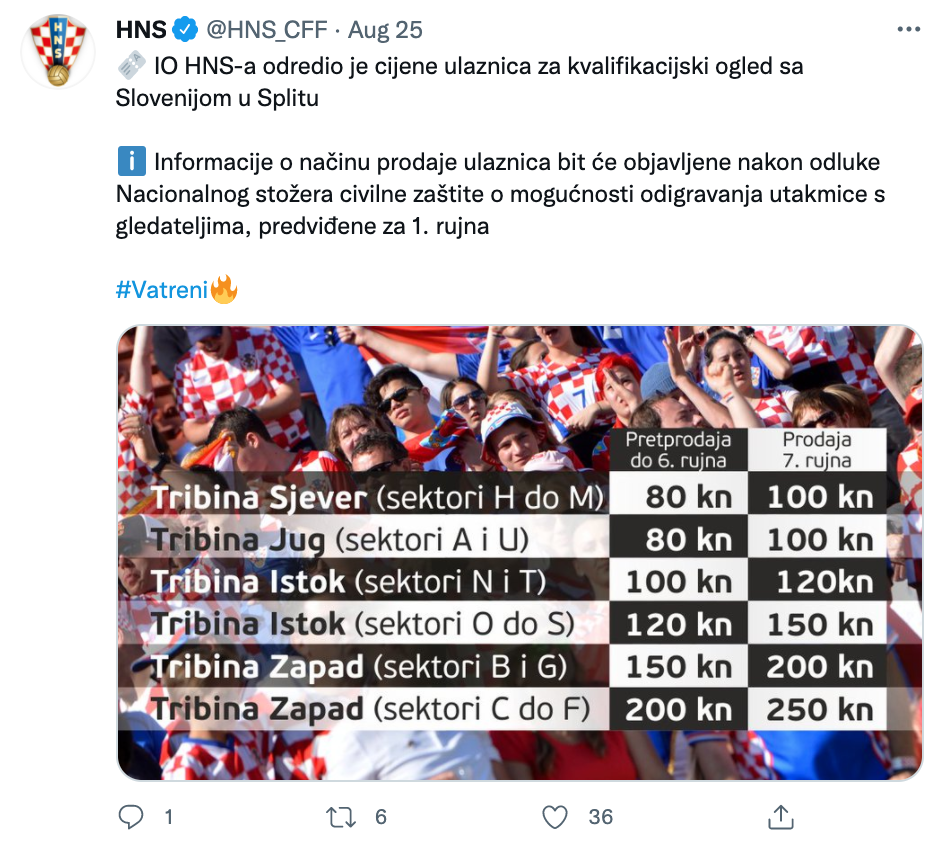
Ticket sales are organized exclusively via the Internet at the following prices:
Ticket prices presale / until September 6 (TICKET PORTAL):
West middle: 200 kn
West: 150 kn
East middle: 120 kn
East: 100 kn
North / South: 80 kn
Ticket prices (on the day of the match):
West middle: 250 kn
West: 200 kn
East middle: 150 kn
East: 120 kn
North / South: 100 kn
ALL PERSONS COMING TO THE STADIUM WITH YOU MUST HAVE AN EU DIGITAL COVID CERTIFICATE.
Please note that vaccination certificates or illness certificates will not be recognized and various test results, but only the EU digital COVID certificate with a valid QR code that will be checked at the entrance.
Children under the age of 12 who have a ticket can enter the stadium without an EU digital COVID certificate if accompanied by a parent or guardian who has a certificate and a ticket.
Information on how to download EU digital COVID certificates can be found at the following link: https://eudigitalnacovidpotvrda.hr/hr/cesta-pitanja.
Fans who have not been vaccinated or have recovered from COVID-19 on arrival at the stadium will be tested through rapid antigen tests. The price of the test will be 50 kn per person, and the test point will be open in front of the Spaladium Arena in the following terms:
Monday, Sept. 6, from 12:00 to 22:00
Tuesday, Sept. 7, 9:00 to 21:00
Ticket sales include e-tickets that the customer must download and print. Only citizens of the Republic of Croatia have the right to purchase by filling in the required personal information.
Due to special epidemiological measures in the stands, one person can buy up to four (4) tickets. In addition to their data, the buyer enters data on another fan for whom they buy tickets, where another fan does not necessarily have to be a citizen of the Republic of Croatia, but cannot be a citizen of the Republic of Slovenia due to UEFA epidemiological measures banning ticket sales to visiting fans for September qualifiers.
Tickets will be available online, where you can find detailed information on ticket sales and payment methods.
"We warn the fans that when entering the stadium, security will check the accuracy of personal data on the tickets and that fans who try to enter the stadium with a ticket in another name will be denied entry. Therefore, we warn fans not to buy tickets on the "black market" with other information on the ticket," concluded HNS.
To follow the latest sports news in Croatia, follow TCN's dedicated page.
To learn more about sport in Croatia, CLICK HERE.
World's Best Naive Art: Authentically Croatian Hlebine School
September 1, 2021 – We visit Podravina to discover the incredible Hlebine School of Croatian Naive Art
Croatia is sometimes difficult to find. Of course, with modern GPS and Croatia's nine international airports, getting here is no problem. But just where are you when you arrive?
Looking down at your dinner, the plate may hold a dish recognisable across the Mediterranean. Above your head, the architecture could be Roman, Austro-Hungarian or modern, indistinguishable. Ottoman influence lies everywhere from the best-loved handheld snacks to the mountain of slippers in every dwelling's doorway.
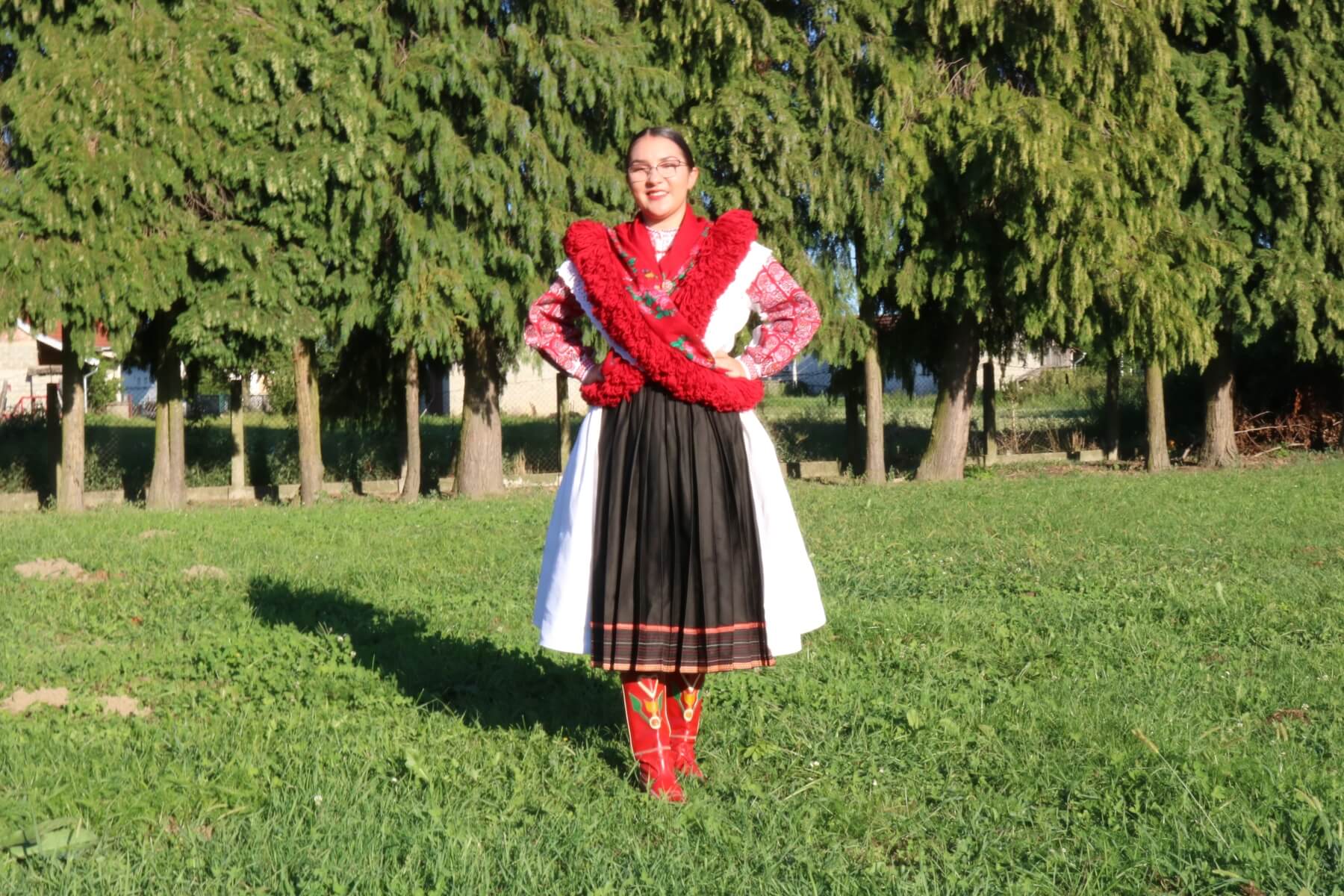 A friendly local wears the folk costume of the small region surrounding Koprivnički Ivanec, near Koprivnica. The costume features the incredibly intricate Ivanečki vez embroidery, which has been safeguarded locally for over 90 years and is now a protected part of Croatia's cultural heritage. Photo © Marc Rowlands.
A friendly local wears the folk costume of the small region surrounding Koprivnički Ivanec, near Koprivnica. The costume features the incredibly intricate Ivanečki vez embroidery, which has been safeguarded locally for over 90 years and is now a protected part of Croatia's cultural heritage. Photo © Marc Rowlands.
Actually, the true essence of the country you'll find in the Croatians themselves. And yet, their history is all too often obscured by the impositions of empires that once were here. However, we can find this history away from the major cities, the centres of influence. We find it in the villages. Specifically, in their folk costume, their folk song and folk dance. And we find it in the art there.
What is Naive Art?
 Cows In The Woods by Ivan Generalić, hanging at the Galerija naivne umjetnosti (Gallery of Naive Art), Hlebine © Koprivnica Town Museum
Cows In The Woods by Ivan Generalić, hanging at the Galerija naivne umjetnosti (Gallery of Naive Art), Hlebine © Koprivnica Town Museum
Naive art is any art made by someone who has received no formal or classical training. In this sense, the earliest discovered art of humans – cave paintings – are naïve art. However, there is nothing the classical art world likes more than specifically defining art movements. And, to them, the modern era of European Naive Art begins in the late 19th Century, with a growing appreciation of painters like French Post-Impressionist Henri Rousseau (1844–1910).
Because of the lack of formal, classical or academic training, it is said that common characteristics exist within the work of many Naive Artists. Specifically, these characteristics stem from an ignorance of strict perspective. Naive Artists often do not mute colours or lessen detail with distance. Also, they often don't attempt to accurately decrease the size of objects at distance.
Croatian culture as a part of national identity
 Horned horse by Ivan Generalić, hanging at the Galerija naivne umjetnosti (Gallery of Naive Art), Hlebine © Koprivnica Town Museum
Horned horse by Ivan Generalić, hanging at the Galerija naivne umjetnosti (Gallery of Naive Art), Hlebine © Koprivnica Town Museum
Croatian Naive Art is one of the best recognised and best-loved in the world. In truth, Croatia's movement doesn't begin to emerge until well into the 20th Century. Although, it is important to view the country's Naive Art within its broader search for a Croatian national identity. The roots of this movement stem back over 100 years prior to the emergence of Croatian Naive Art, beginning with the foundation of the Illyrian movement, Matica Hrvatska and more.
This older movement of national awakening had strong preoccupations with language, written text and cultural identity. Actually, its instigators were very much the educated intelligentsia of cities like Zagreb.
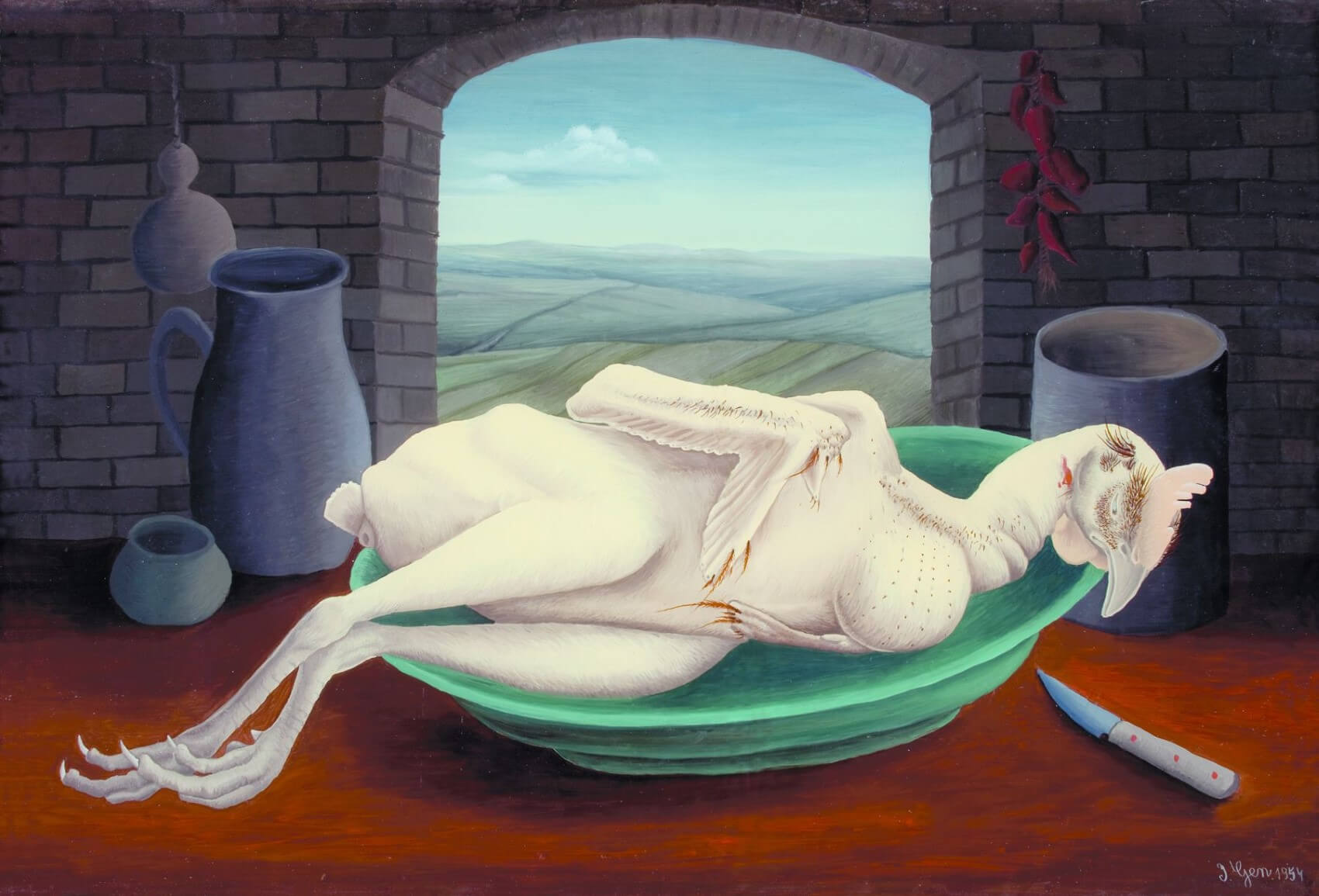 'A Battered Rooster' by Ivan Generalić, hanging at the Galerija naivne umjetnosti (Gallery of Naive Art), Hlebine © Koprivnica Town Museum
'A Battered Rooster' by Ivan Generalić, hanging at the Galerija naivne umjetnosti (Gallery of Naive Art), Hlebine © Koprivnica Town Museum
Before the end of World War I, Russia had undergone two revolutions. After the war, the German, Austro-Hungarian and Ottoman empires collapsed. Much of Europe was plunged into over half a decade of political upheaval - revolts, unrest and strikes by workers. Mostly socialist in sentiment - organised by workers and disillusioned former soldiers – this unrest and the accompanying birth of new nations lay not in the hands of the inner-city intelligentsia. And, many believed the cultural and artistic expression which reflected this new era should also come from the proletariat.
Krsto Hegedušić and the Earth Group (Grupa Zemlja)
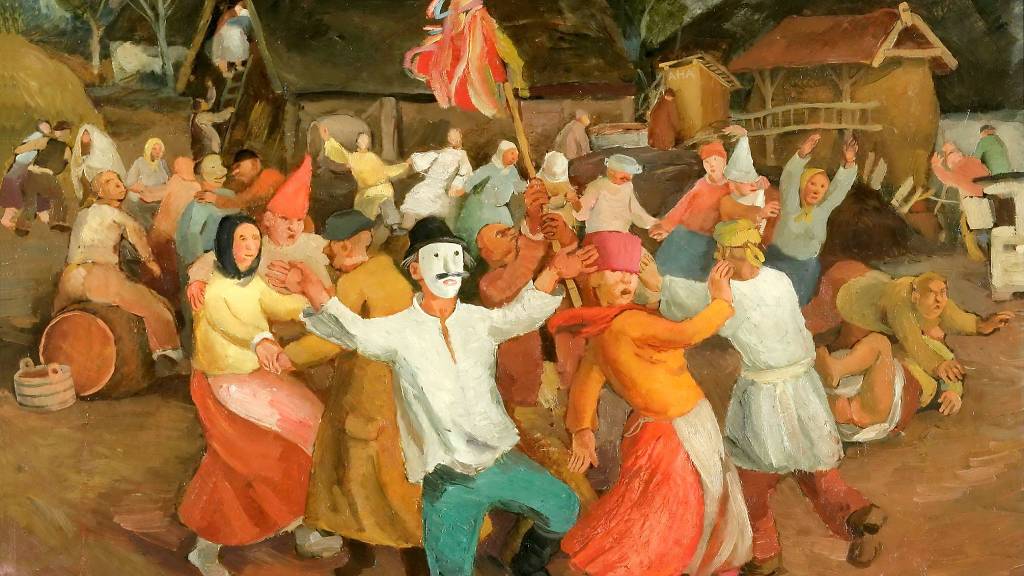 Krsto Hegedušić 'poklade' © Muzej moderne i suvremene umjetnosti Rijeka (MMSU)
Krsto Hegedušić 'poklade' © Muzej moderne i suvremene umjetnosti Rijeka (MMSU)
One Croat who believed strongly in this was painter Krsto Hegedušić. He co-founded the Earth Group in 1929 during a challenging period for Croatia. Europe was still reaping the dire economic repercussions of the First World War. Croatia had finally been freed of Austro-Hungarian hegemony, only to be forced into existing within another monarchy.
The founding beliefs of the Earth Group were that authentic artistic expression should be a product of the time and space whence it came and should be free of foreign influence. Art should not be created for the sake of art, but to depict an actual reality.
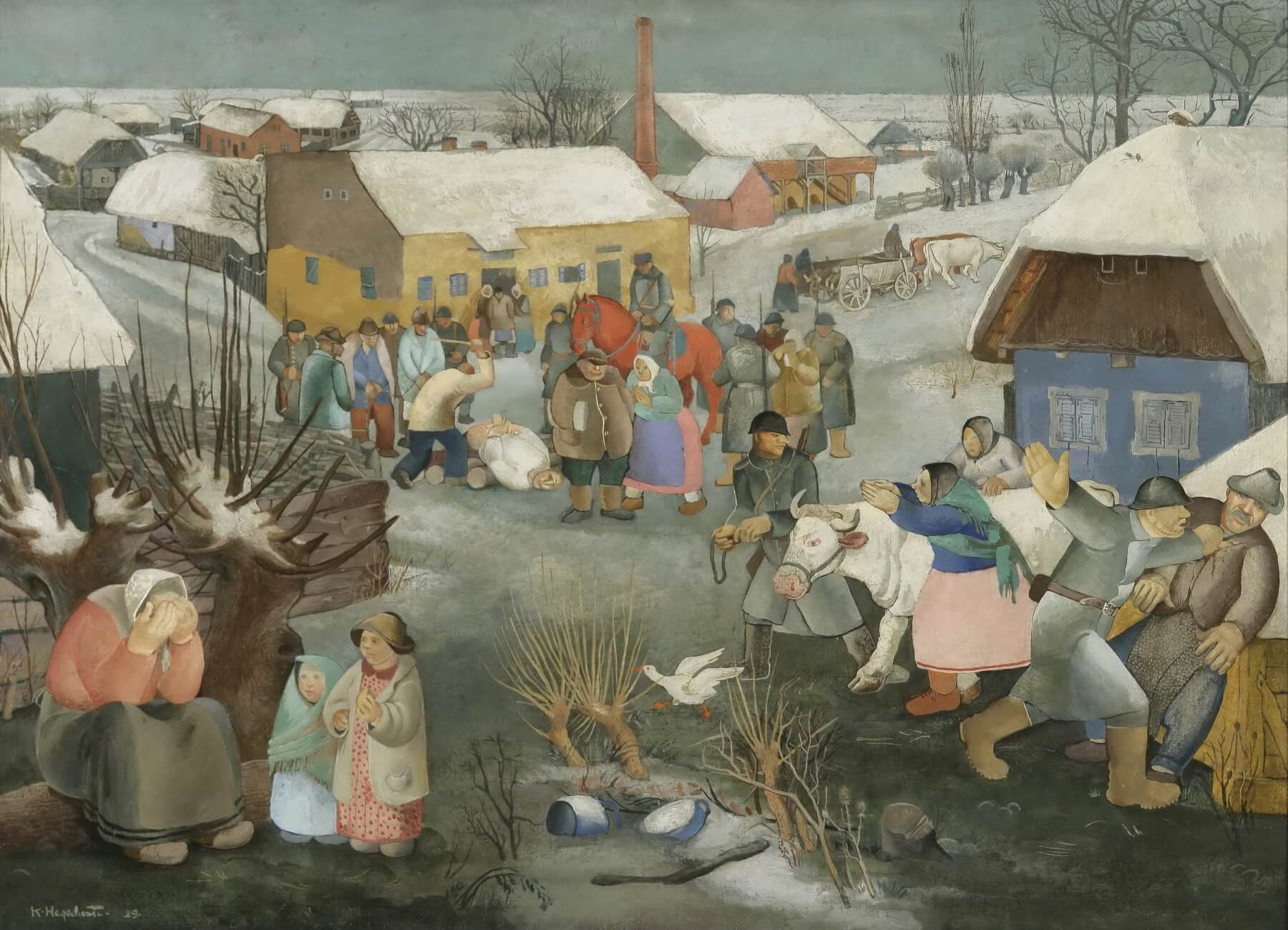 Krsto Hegedušić 'Rekvizicija (Requisition)', 1929 © Museum of Modern and Contemporary Art, Rijeka
Krsto Hegedušić 'Rekvizicija (Requisition)', 1929 © Museum of Modern and Contemporary Art, Rijeka
Krsto Hegedušić himself was very much a product of his studies. In 1920 he enrolled in what is today the Academy of Fine Arts in Zagreb. After graduating, he spent an additional two years on a scholarship in Paris. And yet, as a painter, his subject matter often reflected the world around him. Social critiques, within his work he depicted everyday poverty and the exploitation of Croatian peasants.
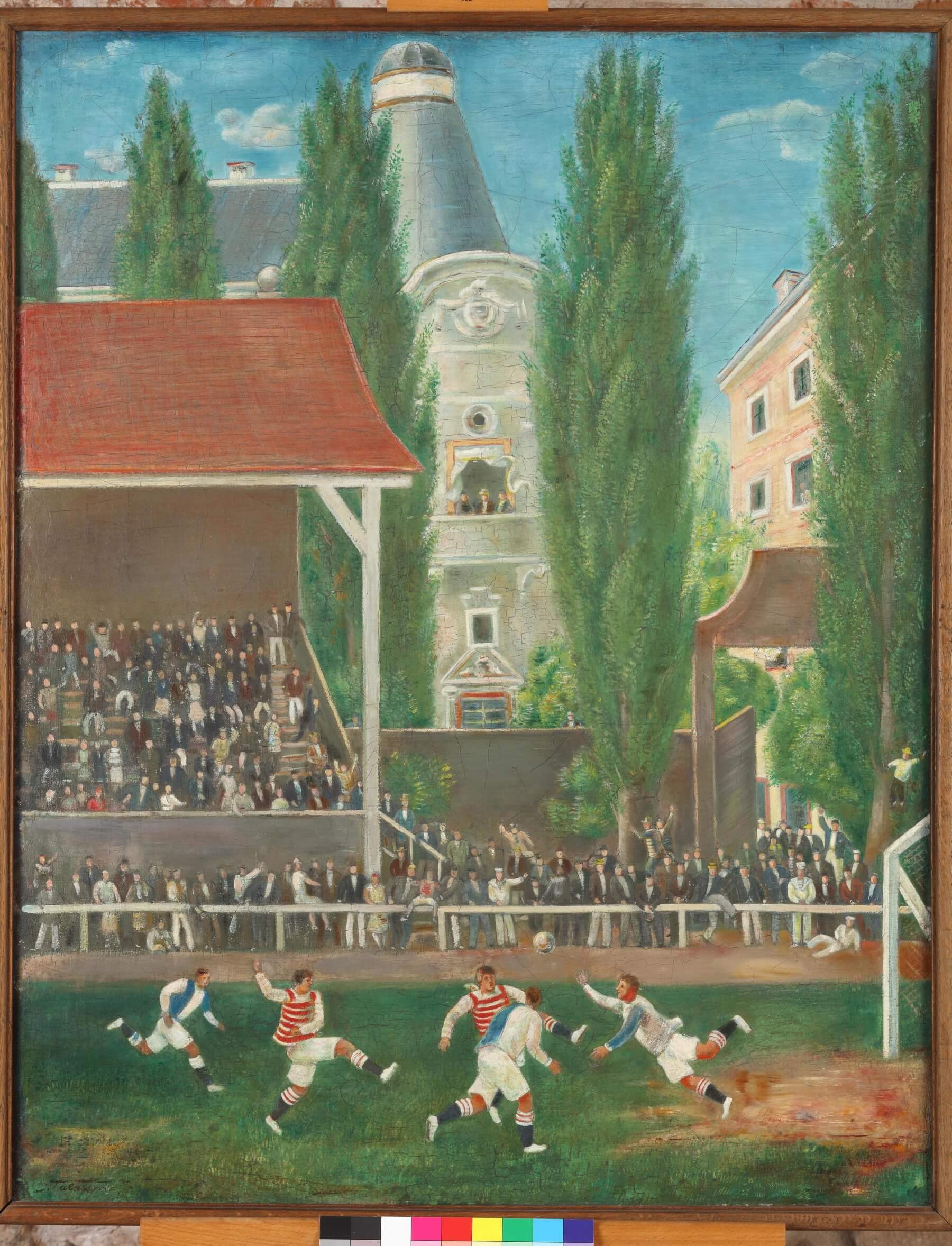 'Football match' by another of the Earth Group's founding members, Ivan Tabaković, 1927 © Gallery of Matica srpska, Novi Sad
'Football match' by another of the Earth Group's founding members, Ivan Tabaković, 1927 © Gallery of Matica srpska, Novi Sad
Born in Petrinja, Krsto Hegedušić spent summer holidays in the idyllic countryside and agricultural land surrounding his father's birth village of Hlebine, Podravina. When he was aged just 8 years old, Krsto's father died. Subsequently, the family moved to Hlebine. Later, Krsto would spend time living in Zagreb, not least for the duration of his studies. But, just one year into the life of the Earth Group, Krsto Hegedušić discovered a teenage artist back in Hlebine.
Hlebine School First Generation: Ivan Generalić, Franjo Mraz and Mirko Virius
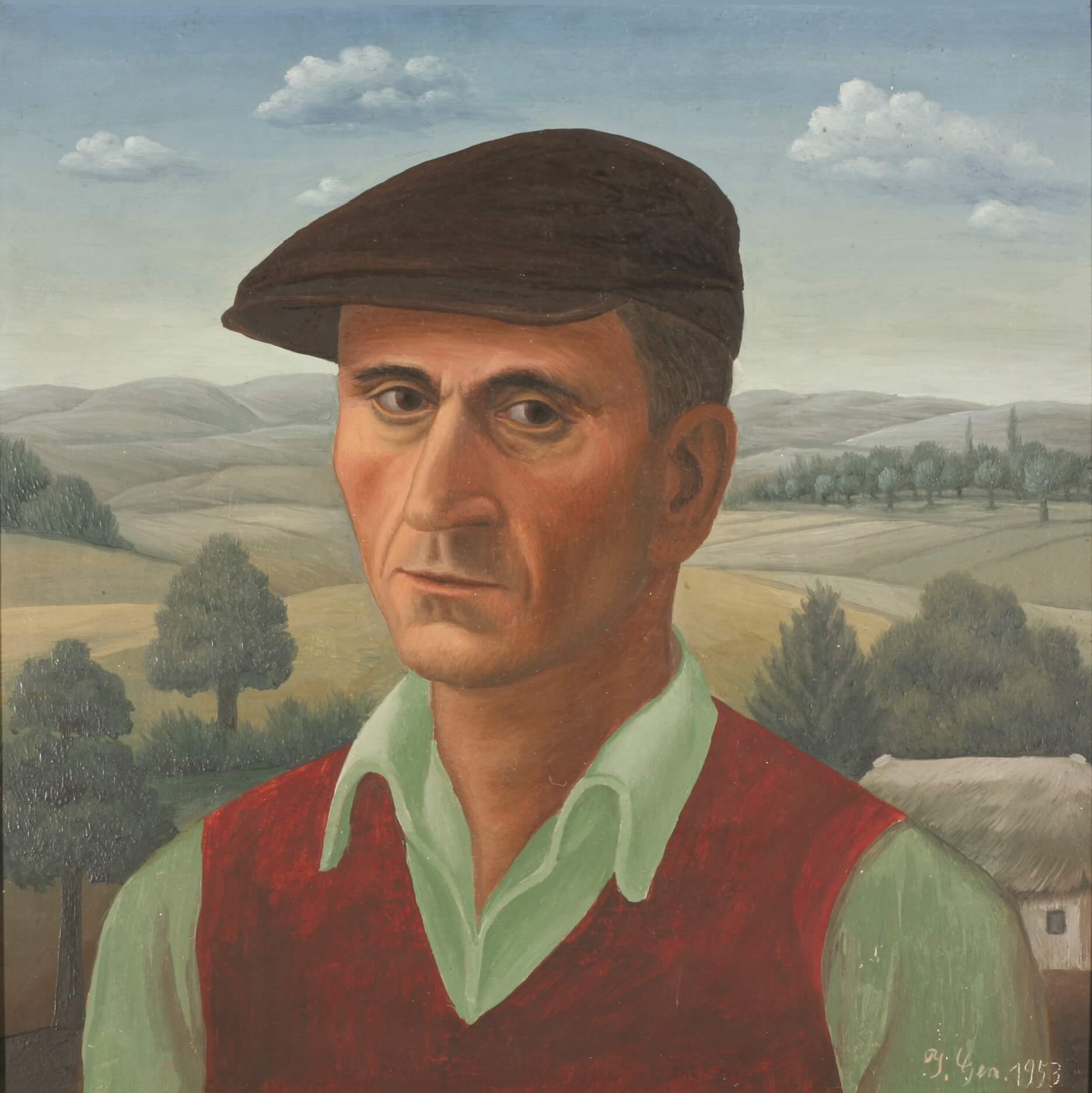 Self-portrait by Ivan Generalić, hanging at the Galerija naivne umjetnosti (Gallery of Naive Art), Hlebine. Photo © Koprivnica Town Museum
Self-portrait by Ivan Generalić, hanging at the Galerija naivne umjetnosti (Gallery of Naive Art), Hlebine. Photo © Koprivnica Town Museum
When we speak of the Hlebine School within Croatian Naive Art we are not actually talking about a building, an institution of learning. After all, the very definition of a Naive Artist is they are not classically trained. Instead, the Hlebine School is a discipline. And, more so than any Croatian Naive Art that followed, it is quite easy to define.
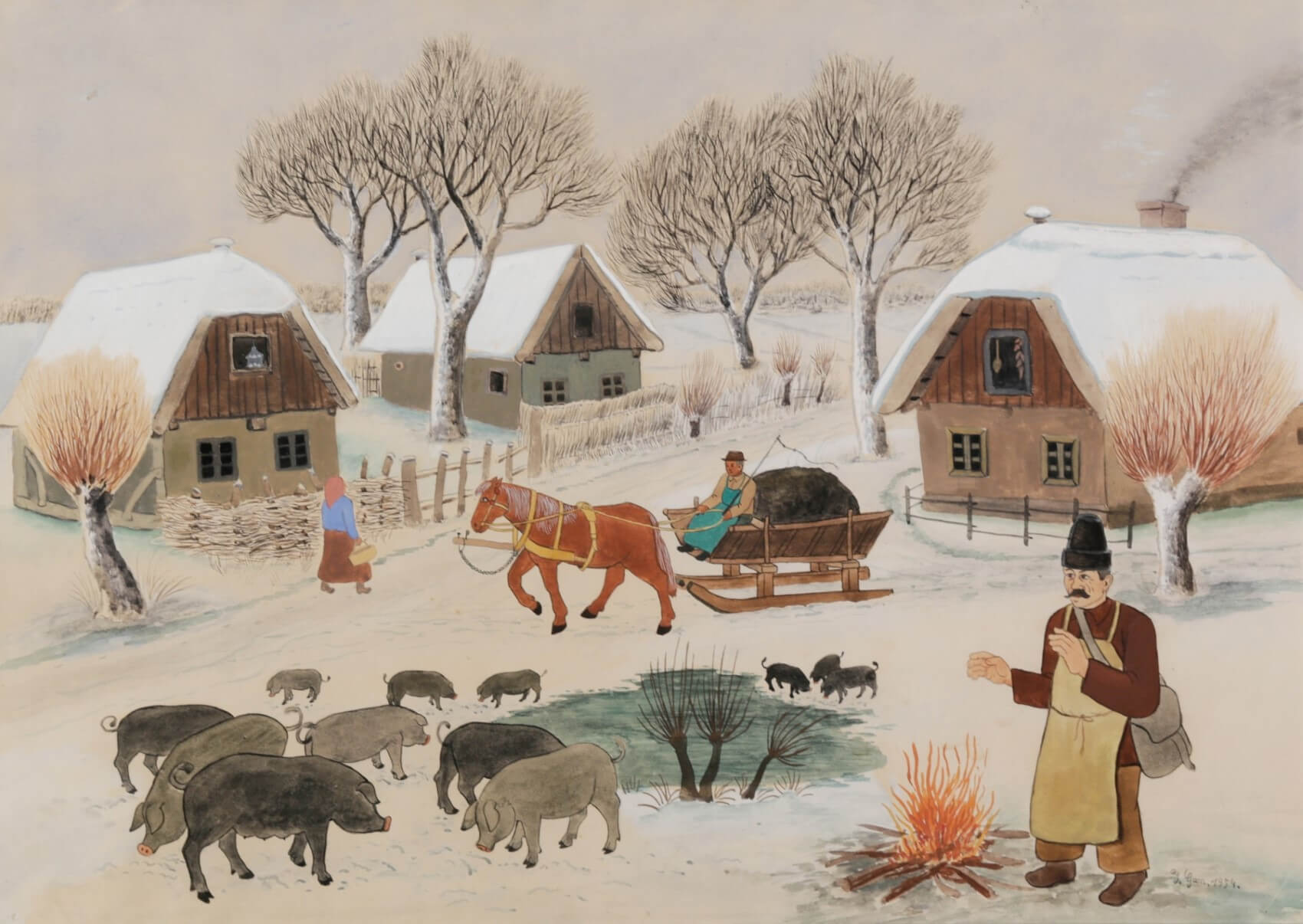 'Kanas' by Ivan Generalić, hanging at the Galerija naivne umjetnosti (Gallery of Naive Art), Hlebine © Koprivnica Town Museum
'Kanas' by Ivan Generalić, hanging at the Galerija naivne umjetnosti (Gallery of Naive Art), Hlebine © Koprivnica Town Museum
Within its first generation, the three most prominent artists are Ivan Generalić, Franjo Mraz and Mirko Virius. Both Ivan Generalić and Franjo Mraz were born, lived and were discovered by Krsto Hegedušić in the village of Hlebine. Mirko Virius was from Đelekovec, less than 15 kilometres to their north-west.
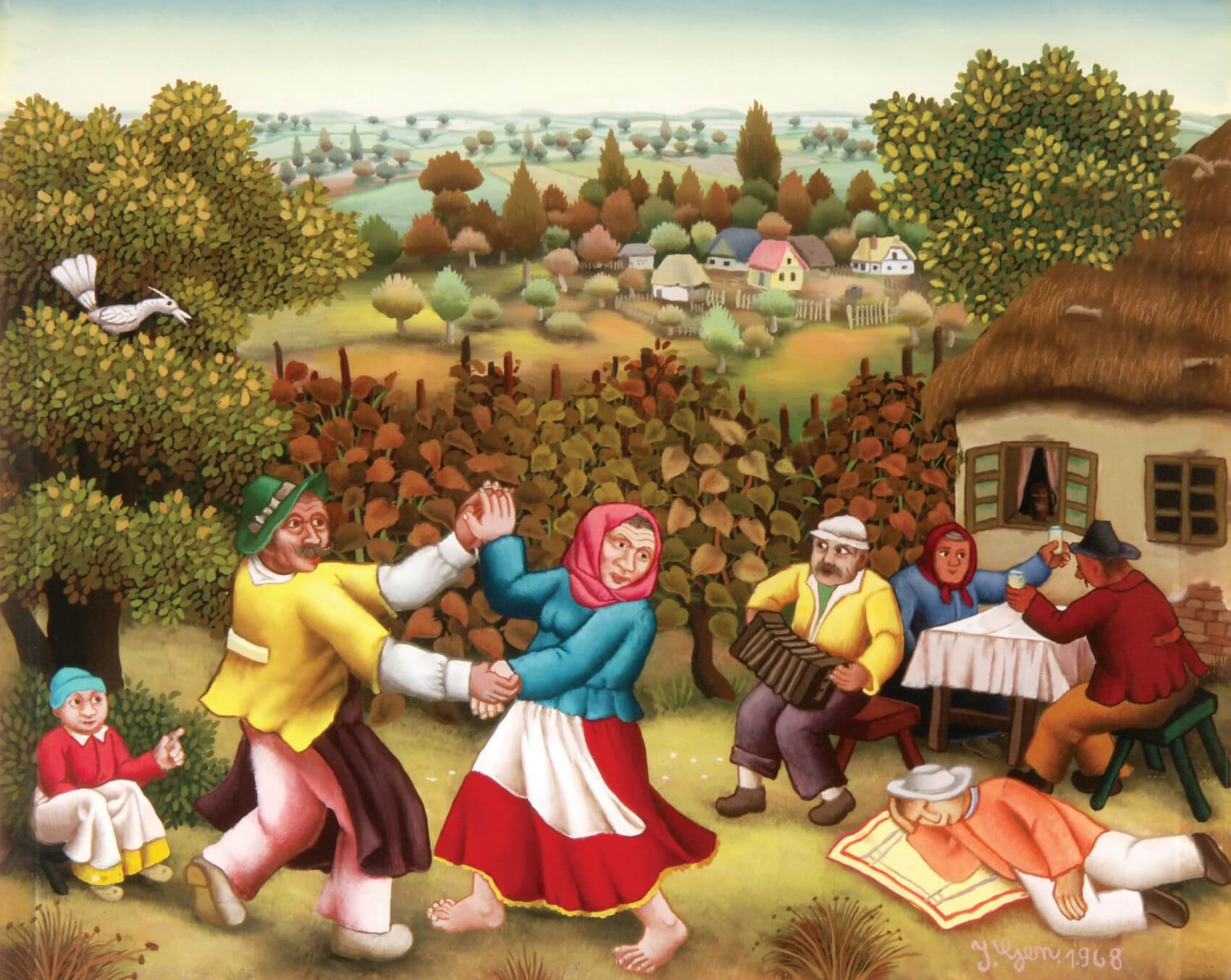 'Ples v goricaj' by Ivan Generalić, hanging at the Galerija naivne umjetnosti (Gallery of Naive Art), Hlebine © Koprivnica Town Museum
'Ples v goricaj' by Ivan Generalić, hanging at the Galerija naivne umjetnosti (Gallery of Naive Art), Hlebine © Koprivnica Town Museum
Key to identifying the Hlebine School in its First Generation is the subject matter. All three of these artists painted the world around them – their neighbours and peers, living everyday lives, in the villages, landscape and towns of today's Koprivnica-Križevci County. Certainly, Krsto Hegedušić helped inspire this subject matter, moulding the artists to suit the ethos of the Earth Group.
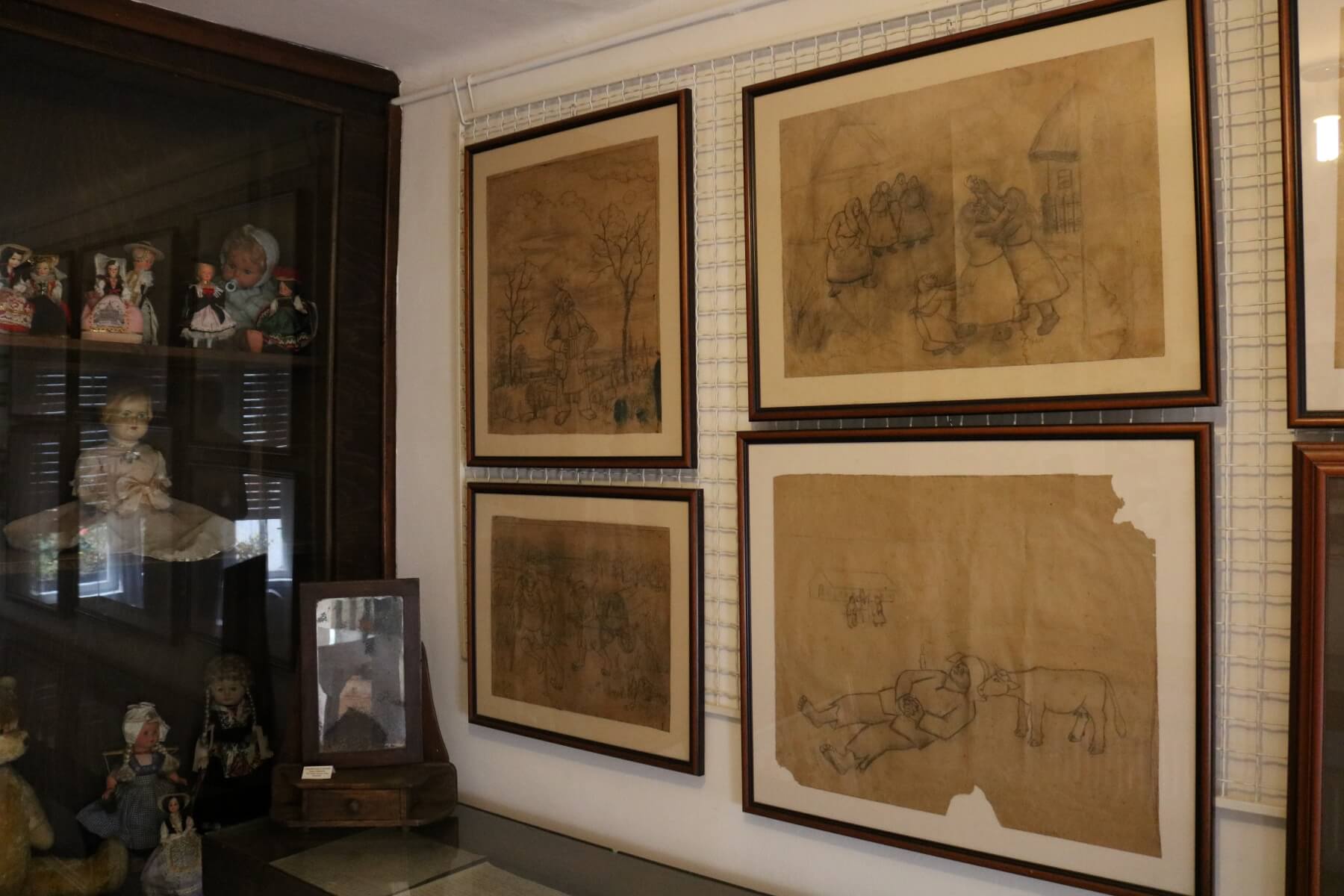
Ivan Generalić was just 16 years old when discovered by Krsto Hegedušić in 1930. The meeting would have a fast and long-lasting impact on Generalić. Ivan's humble early canvasses were the brown paper bags used in the business of a close relative. Yet, within a year of meeting Hegedušić, Ivan Generalić found his work being exhibited in Zagreb.
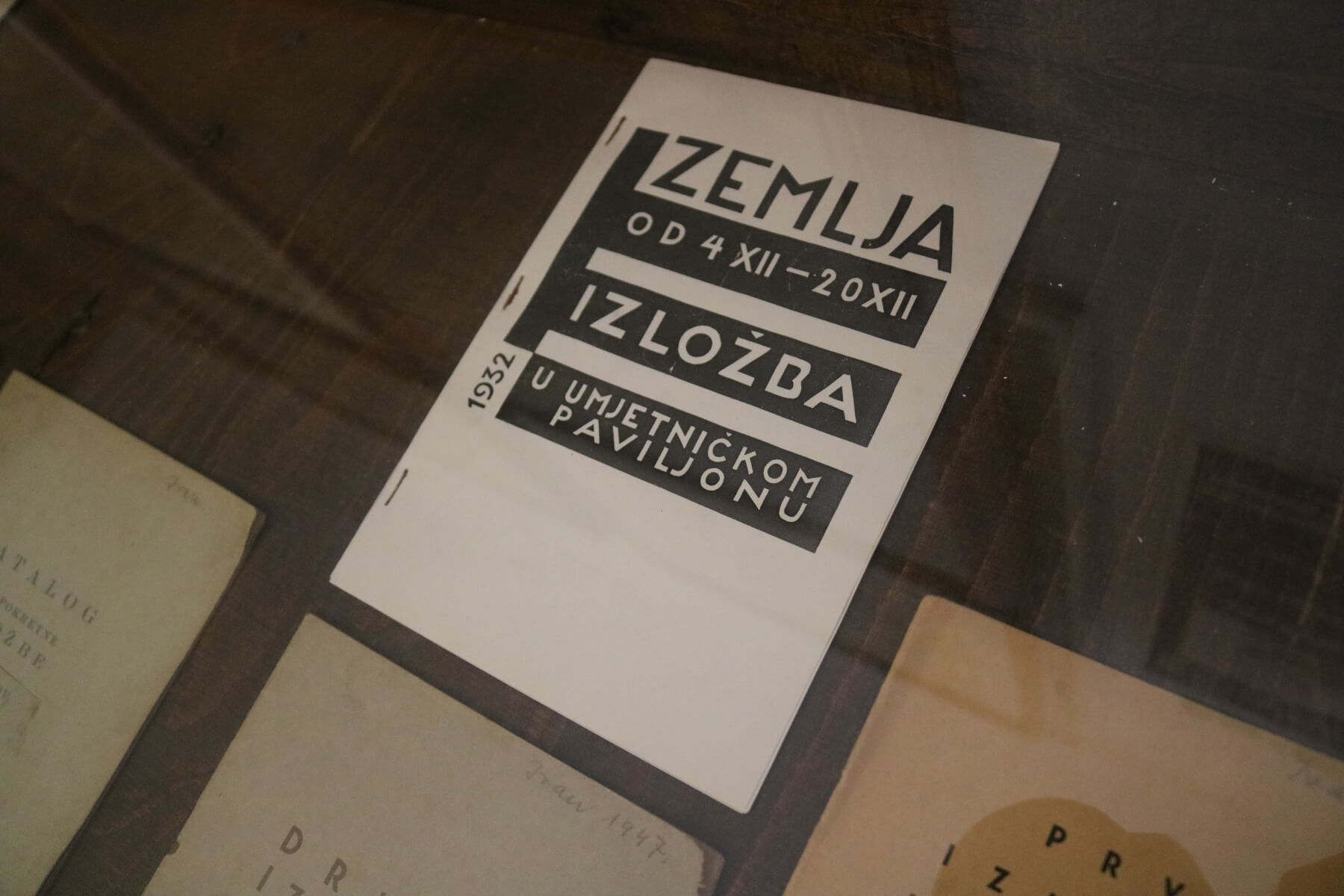
Hegedušić's shaping of the artists didn't obliterate their existing perspectives as much as it simply shifted them. For instance, Hegedušić's advice might have been "Instead of painting the church, why not paint people walking to the church in the snow?" or "Instead of marking the religious holiday by painting its origin story, why not show how you and your neighbours celebrate this holiday?"
Whether Hegedušić was conscious of doing it, or whether the artists were willfully lead, this guidance ultimately had the effect of politicising their work. In turn, this would lead the most authentic of all Croatian art into dangerous times when fascists took over the country. Proletarian in their themes, the Hlebine School and the Earth Group became viewed as Communist. The latter group was banned and Hegedušić arrested several times. During the Second World War, Mirko Virius was arrested, taken to a concentration camp in Zemun and executed. Ivan Generalić's painting of the sorrowful incident, 'The Death of Virius', is among his most famous. Franjo Mraz was also arrested during World War II but managed to escape.
 'Mask' by Ivan Generalić, hanging at the Galerija naivne umjetnosti (Gallery of Naive Art), Hlebine © Koprivnica Town Museum
'Mask' by Ivan Generalić, hanging at the Galerija naivne umjetnosti (Gallery of Naive Art), Hlebine © Koprivnica Town Museum
Aside from informing the subject matter of their work, Hegedušić also educated the painters in different techniques. One of these techniques – painting on glass – would become an enduring component of the Hlebine School and Croatian Naive Art.
Painting on glass
 'Eiffel Tower' by Ivan Generalić. The original hangs at Galerija naivne umjetnosti (Gallery of Naive Art), Hlebine © Koprivnica Town Museum
'Eiffel Tower' by Ivan Generalić. The original hangs at Galerija naivne umjetnosti (Gallery of Naive Art), Hlebine © Koprivnica Town Museum
Copying the style from imported religious art, when Hlebine School artists learned to paint on glass, it gave their efforts several distinct qualities. Firstly, if stored in the right conditions – away from damaging light – the glass protects the colours of the paint. As a result, much Hlebine School art is as brilliantly vivid today as the day it was first painted.
Secondly, this format makes the works heavy and fragile. Several masterpieces have been lost by falling to the floor and smashing.
Thirdly, painting on glass is time-consuming and challenging. Each painting must be thought out and planned in advance. The painter initially makes a sketch or preliminary painting as a guide. The image is then transferred to glass effectively in reverse. Details in the forefront of the painting must be applied first, with the background painted on top. Throughout the process, the artist will continuously check their progress on the opposite side of the glass.
Hlebine School Second Generation and onwards: Josip Generalić, Ivan Večenaj, Ivan Lacković, Mijo Kovačić, Franjo Filipović, Dragan Gaži
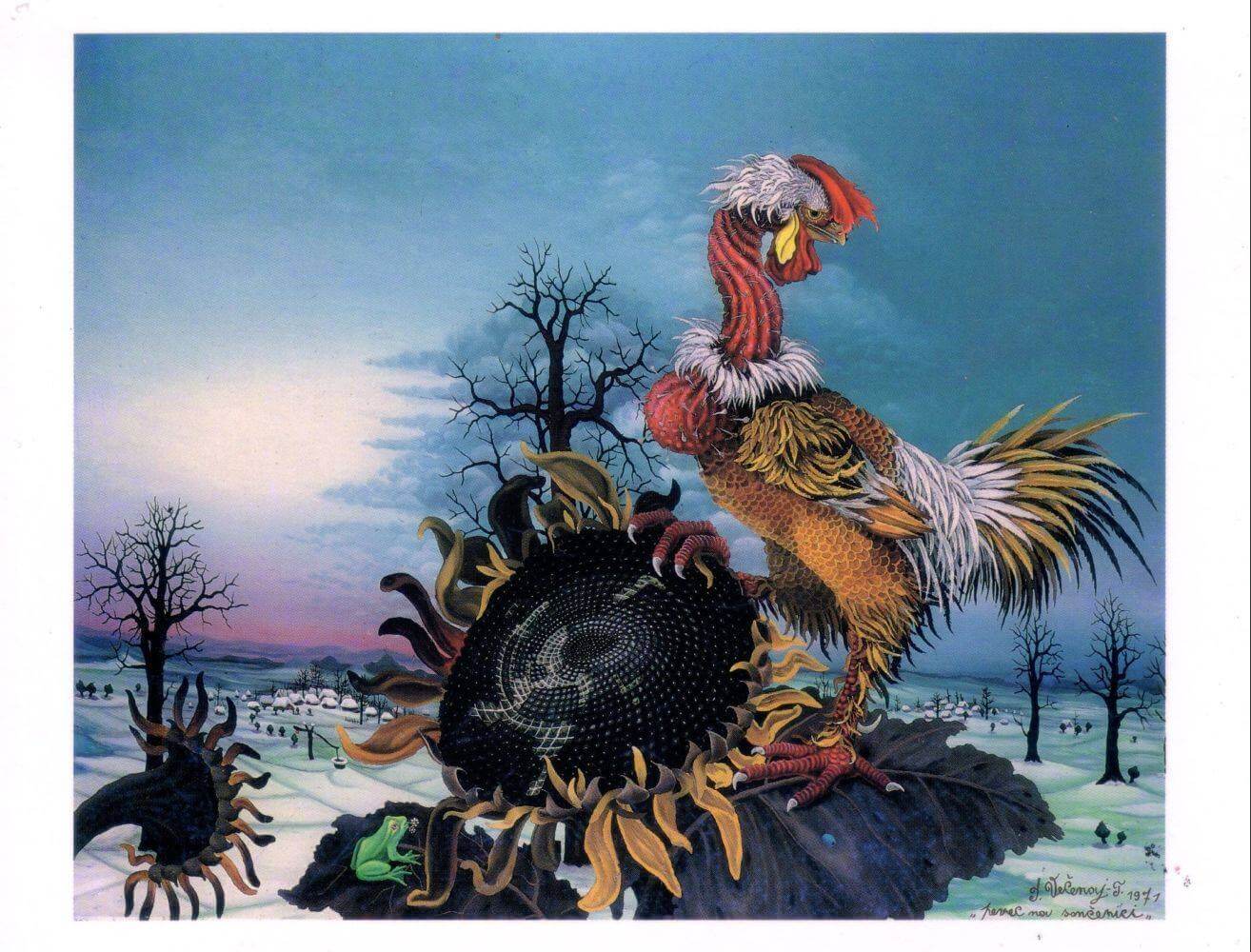 Rooster on Sunflower by Ivan Večenaj © Galerija Ivan Večenaj
Rooster on Sunflower by Ivan Večenaj © Galerija Ivan Večenaj
Perhaps to their surprise, the painters of Hlebine School first generation became a big hit. Exhibitions of their work were appreciated first in Zagreb. But, then the exhibitions began to tour across Yugoslavia and eventually the art capitals of the world. This attention would help inspire a new generation of artists from Hlebine and the surrounding area.
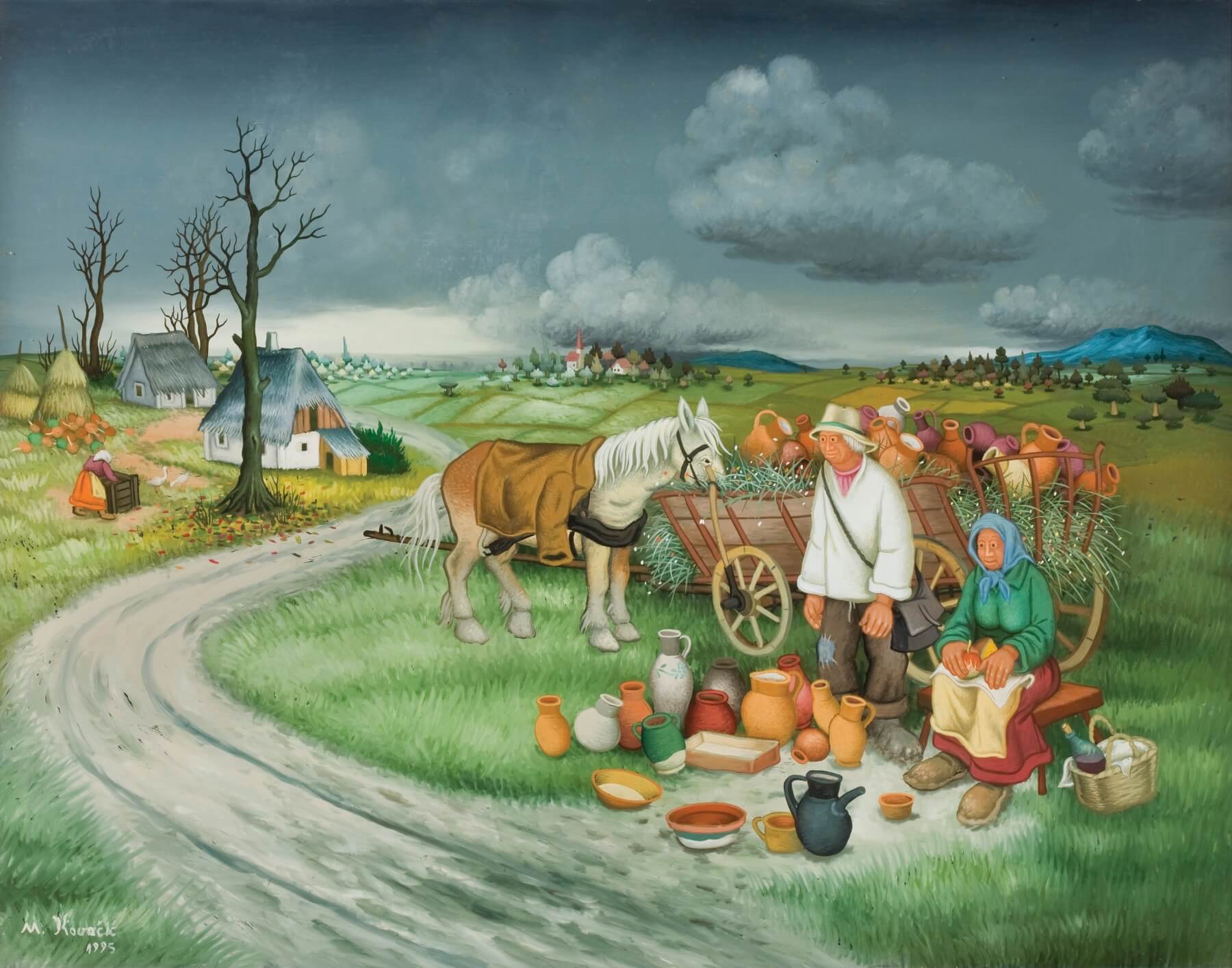 'Lončari' by Mijo Kovačić at Galerija Mijo Kovačić © Koprivnica Town Museum
'Lončari' by Mijo Kovačić at Galerija Mijo Kovačić © Koprivnica Town Museum
Success for the Hlebine School artists showed that Croatian art and self-expression were valid and valued even if unstudied. Thereafter, the tiny village of Hlebine would never look the same. More and more Naive Artists and folk artists were inspired to create. Still to this day, many continue.
While some Hlebine School artists carried on the tradition of painting on glass, others were inspired to sculpt in wood or, like Mirko Virius, paint on canvas. One of the key distinctions between later generations of the Hlebine School and the first is the subject matter.
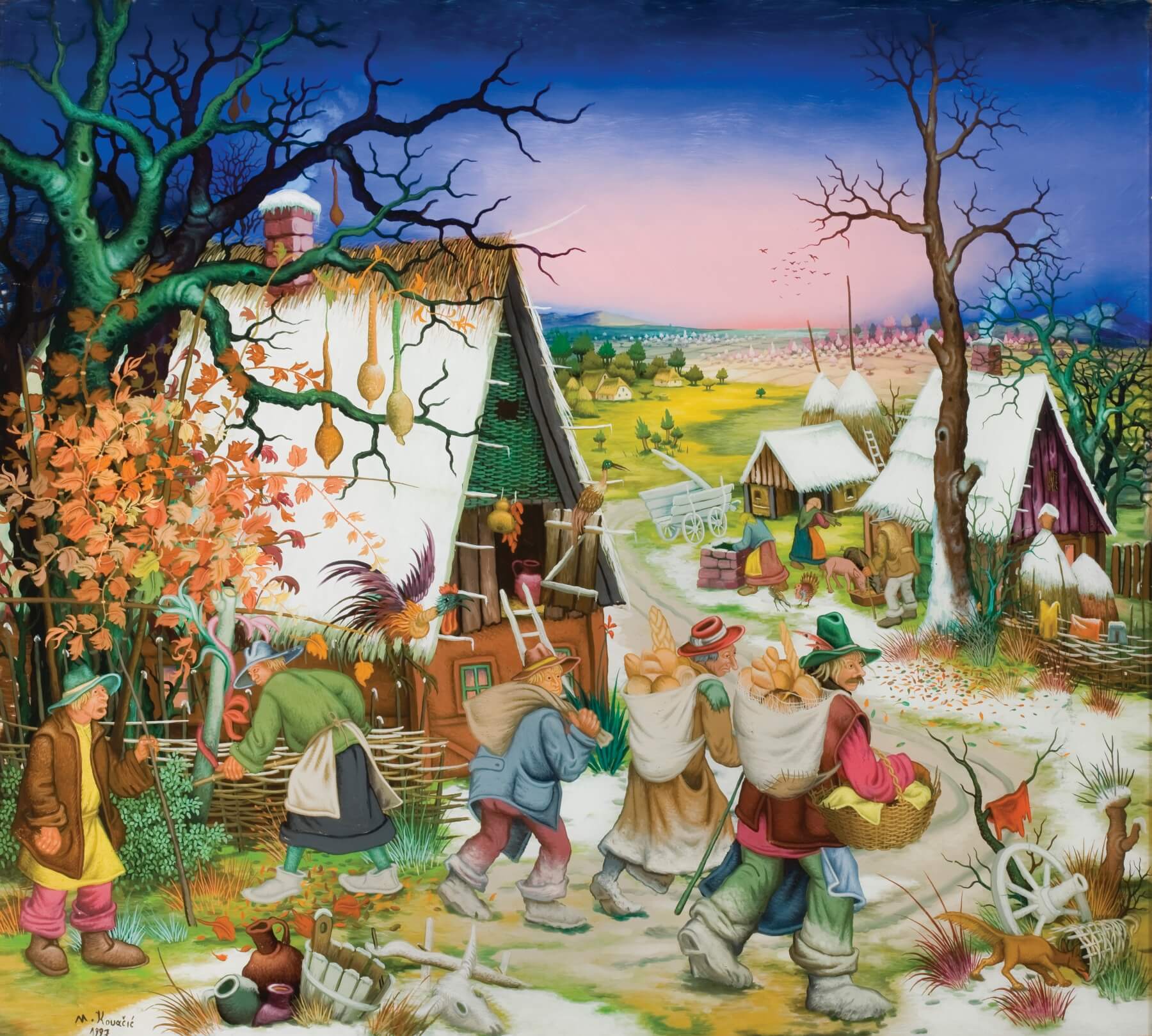 Podravina bread sellers in a picture hanging at Galerija Mijo Kovačić © Koprivnica Town Museum
Podravina bread sellers in a picture hanging at Galerija Mijo Kovačić © Koprivnica Town Museum
Second and then third generation Hlebine School artists were inspired to paint folklore, fantasy, from imagination, and with symbolic uses of vivid colur. This broadening of the style was partially the influence of Dimitrije Bašičević Mangelos, the first curator of the Gallery of Primitive Art in Zagreb (today Croatian Museum of Naïve Art). Subsequently, many of these later works would not fit within the paradigms of the Earth Group.
 'Žabe (Frogs)' by Ivan Večenaj © Galerija Ivan Večenaj
'Žabe (Frogs)' by Ivan Večenaj © Galerija Ivan Večenaj
For example, some of Ivan Večenaj's sacral paintings clearly come from the author's imagination and not his actual vision. Similarly, Josip Generalić, son of Ivan, travelled far beyond the limits of his home village in pursuit of his socio-political subject matter. Both artists were concerned with environmental issues on a global, not just a local level. Although, their work is still inextricably linked to their locale; Večenaj works the Podravina rooster emblem into many of his paintings and even depicts Christ within a Podravina landscape. So too does Josip Generalić when he paints The Beatles and others from the 60s counterculture movement.
On the Trail of the Hlebine School in Podravina & Prigorje, Home of the Treasures of Croatian Naive Art
 Locals return from mushroom picking in autumnal Podravina in a picture hanging at Galerija Mijo Kovačić © Koprivnica Town Museum
Locals return from mushroom picking in autumnal Podravina in a picture hanging at Galerija Mijo Kovačić © Koprivnica Town Museum
Some Croatian Naive Art is held in private and public collections across the world. Some of it finds a home in the National Museum of Naive Art in Zagreb. However, the vast majority of treasures from the Hlebine School of Croatian Naive Art remain in Podravina & Prigorje. The national Museum of Naive Art in Zagreb is currently closed as it undergoes the lengthy process of changing address. As a result, the following addresses in Koprivnica-Križevci County are currently the best places to see the most authentically Croatian of all the country's art.
Also, because the landscape of Hlebine, Koprivnica and wider Podravina appears in so much Hlebine School art, you genuinely need to come here to view both together. You'll get a much better understanding and appreciation of this art when you see it in its natural surroundings.
Galerija Mijo Kovačić, Koprivnica Town Museum, Koprivnica
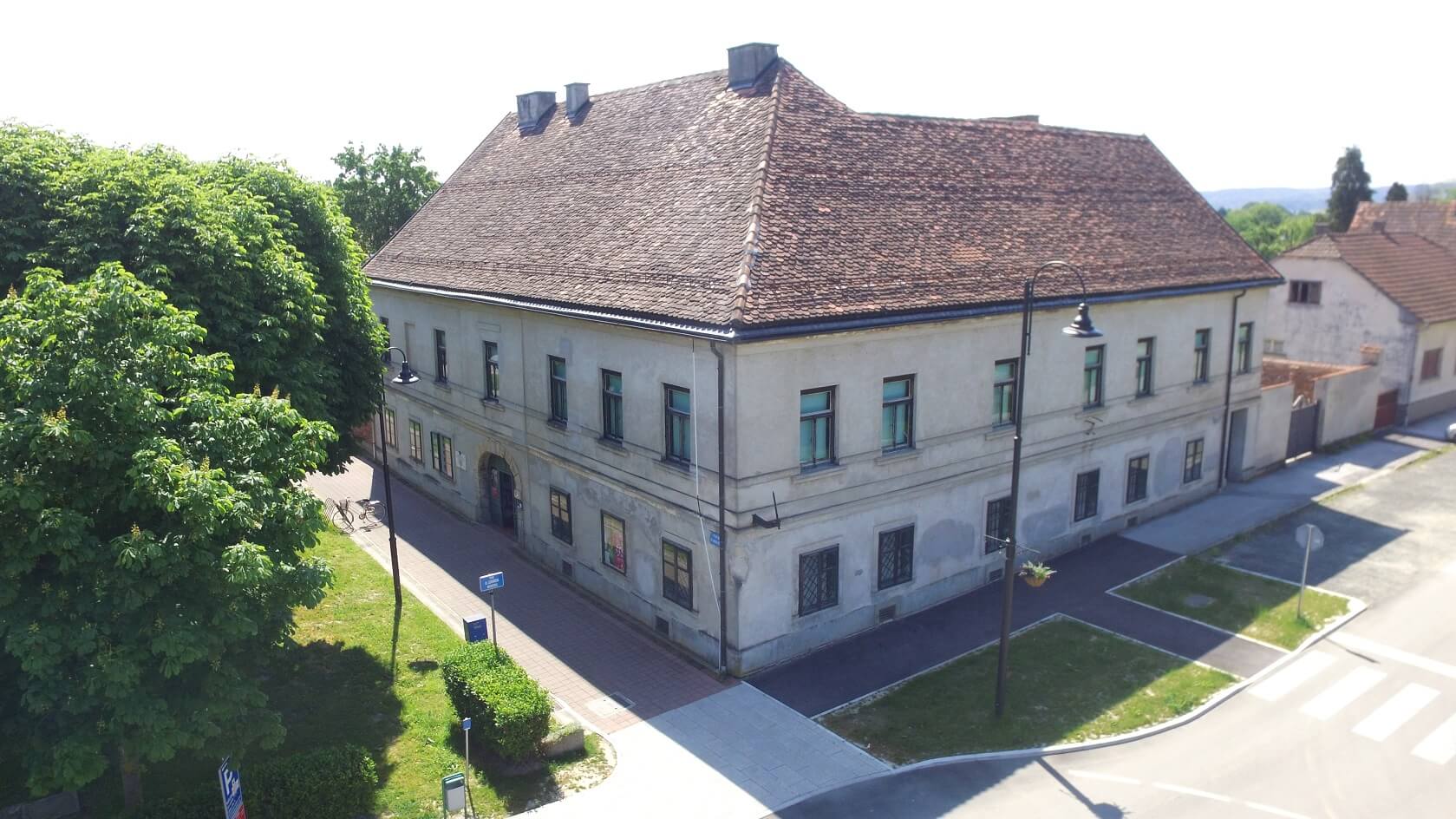 Koprivnica Town Museum © Koprivnica Town Museum
Koprivnica Town Museum © Koprivnica Town Museum
Born 5 August 1935 in Gornja Šuma, Molve, Podravina, Mijo Kovačić is one of the last remaining Croatian Naive Artists of the Hlebine School's second generation. He still paints today, albeit not quite as prolifically as in the past. He has produced such a body of work that not only can you find him exhibited in Croatian Museum of Naïve Art in Zagreb, but also in dedicated Mijo Kovačić galleries in Zagreb and Koprivnica. The one is run by Koprivnica Town Museum, which you can see above. Find out more about the gallery here.
 'Portrait' hanging at Galerija Mijo Kovačić © Koprivnica Town Museum
'Portrait' hanging at Galerija Mijo Kovačić © Koprivnica Town Museum
Galerija naivne umjetnosti (Gallery of Naive Art), Hlebine
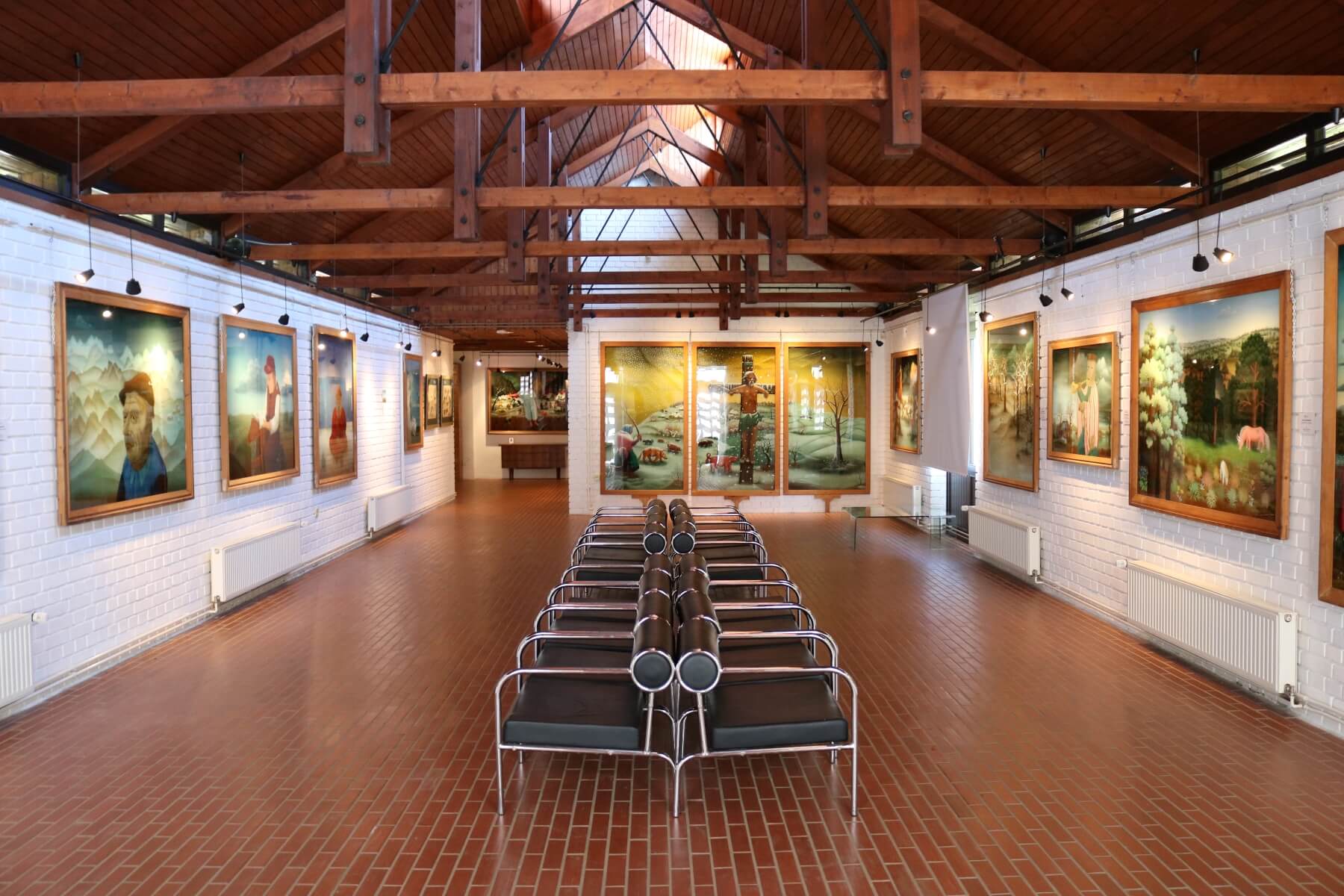
Founded in 1968, the Gallery of Naive Art in Hlebine is one of the top two most important galleries for Naïve Art in Croatia, the other being the Croatian Museum of Naïve Art in Zagreb. But, unlike their Zagreb counterpart, this gallery concentrates specifically on the Hlebine School and locally produced art. A crowd of sculpted wooden figures greets you on the front lawn. Inside, beneath the wooden beams of a beautiful building designed specifically for this purpose, some of the best artists and paintings of the Hlebine School.
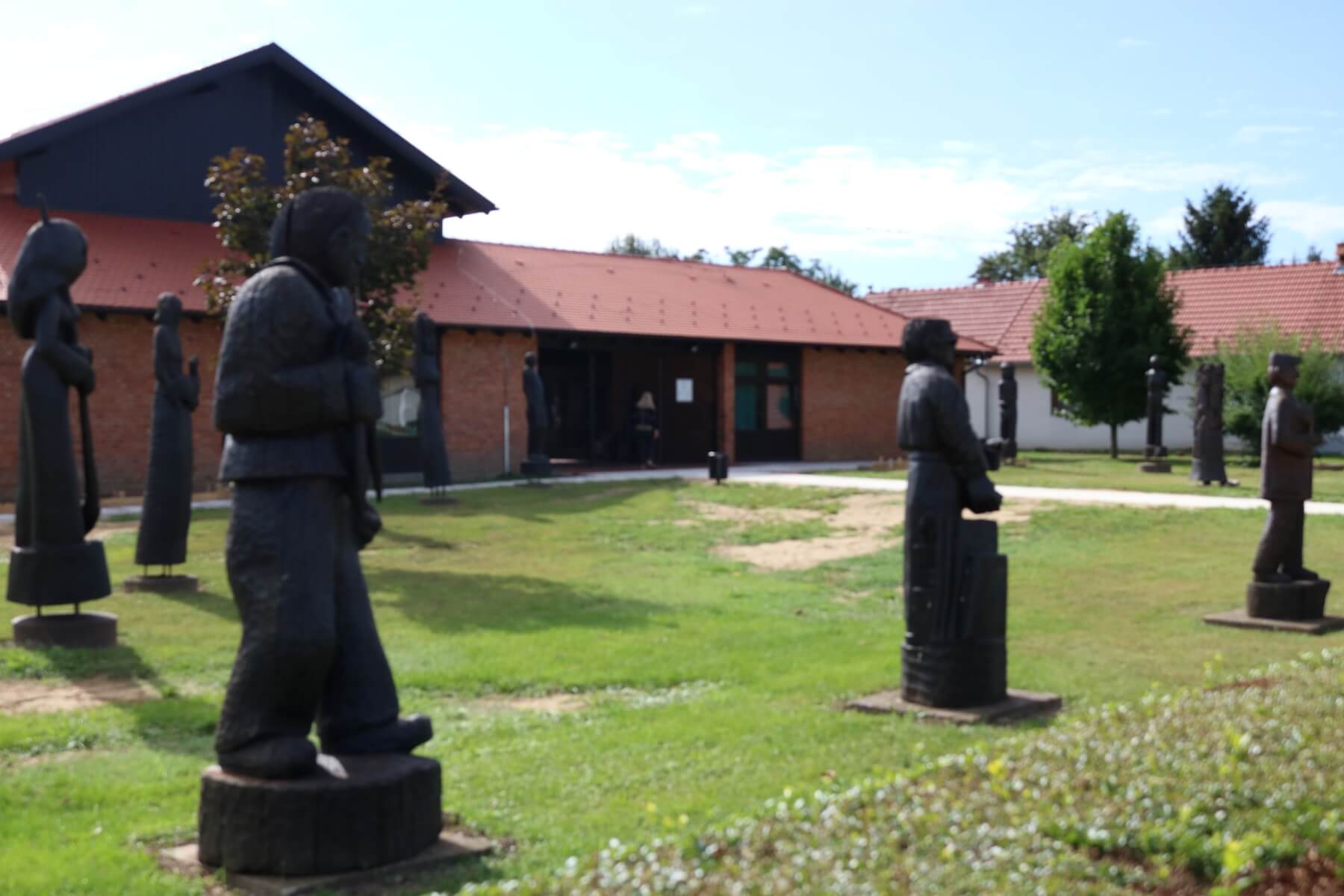
In the mid-1980s, when he was the most famous of all Croatian Naive Artists, neighbour Ivan Generalić paid the gallery a visit. He offered to pay for an extension to the gallery, on condition that it be used to house a permanent exhibition of his work. It was a win-win for the museum and Ivan Generalić subsequently donated some of his true masterpieces for the collection.
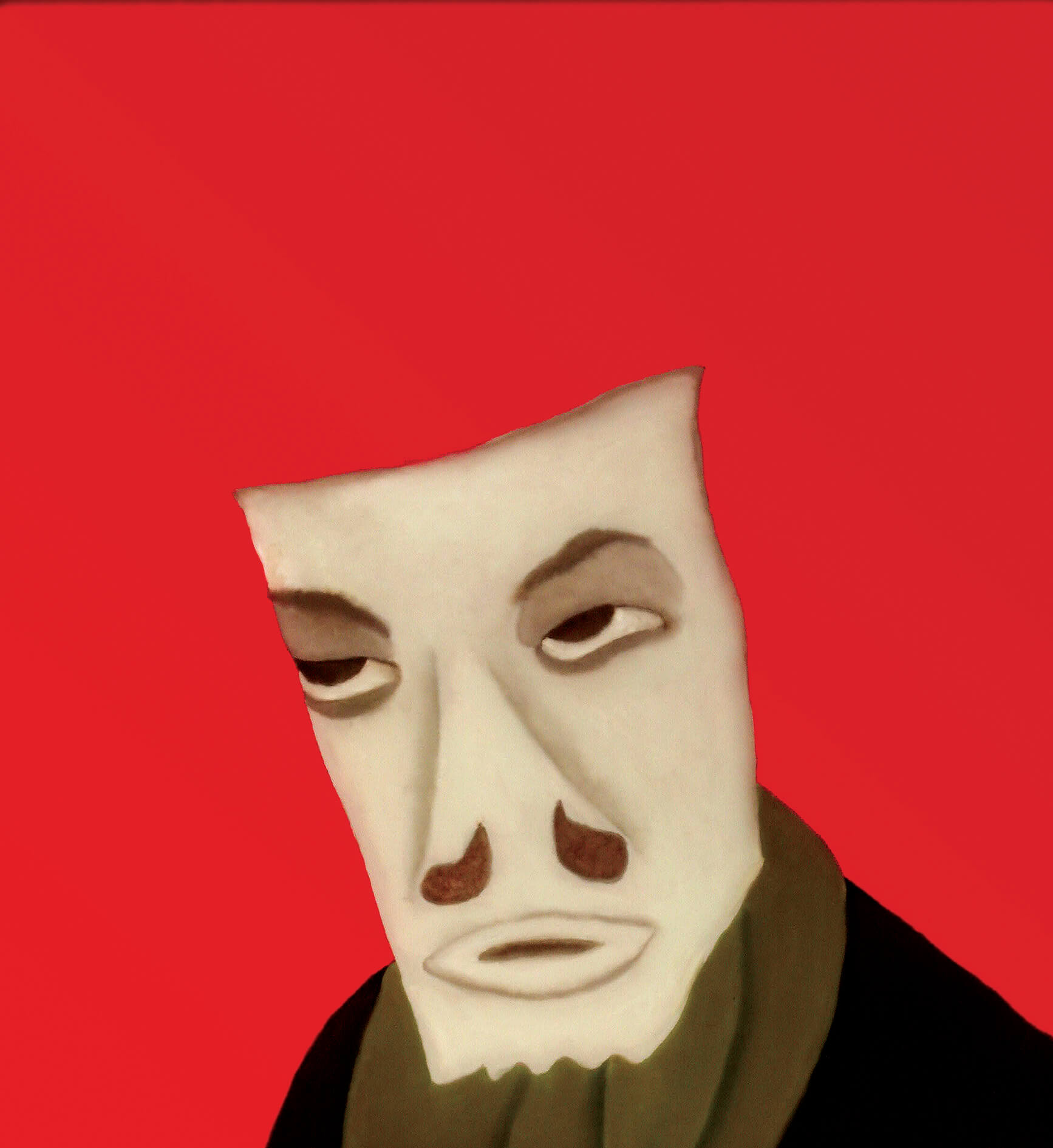
The newer part of the gallery is so true to the original design that, unless informed, you'd never guess it was built later. You'll find works by every key member of the Hlebine School here, including Ivan Generalić, Franjo Mraz and Mirko Virius, Josip Generalić, Ivan Večenaj, Ivan Lacković, Mijo Kovačić, Franjo Filipović and Dragan Gaži. Today, the museum is run by Koprivnica Town Museum. Find out more about the gallery here.
Galerija Josip Generalić, Hlebine
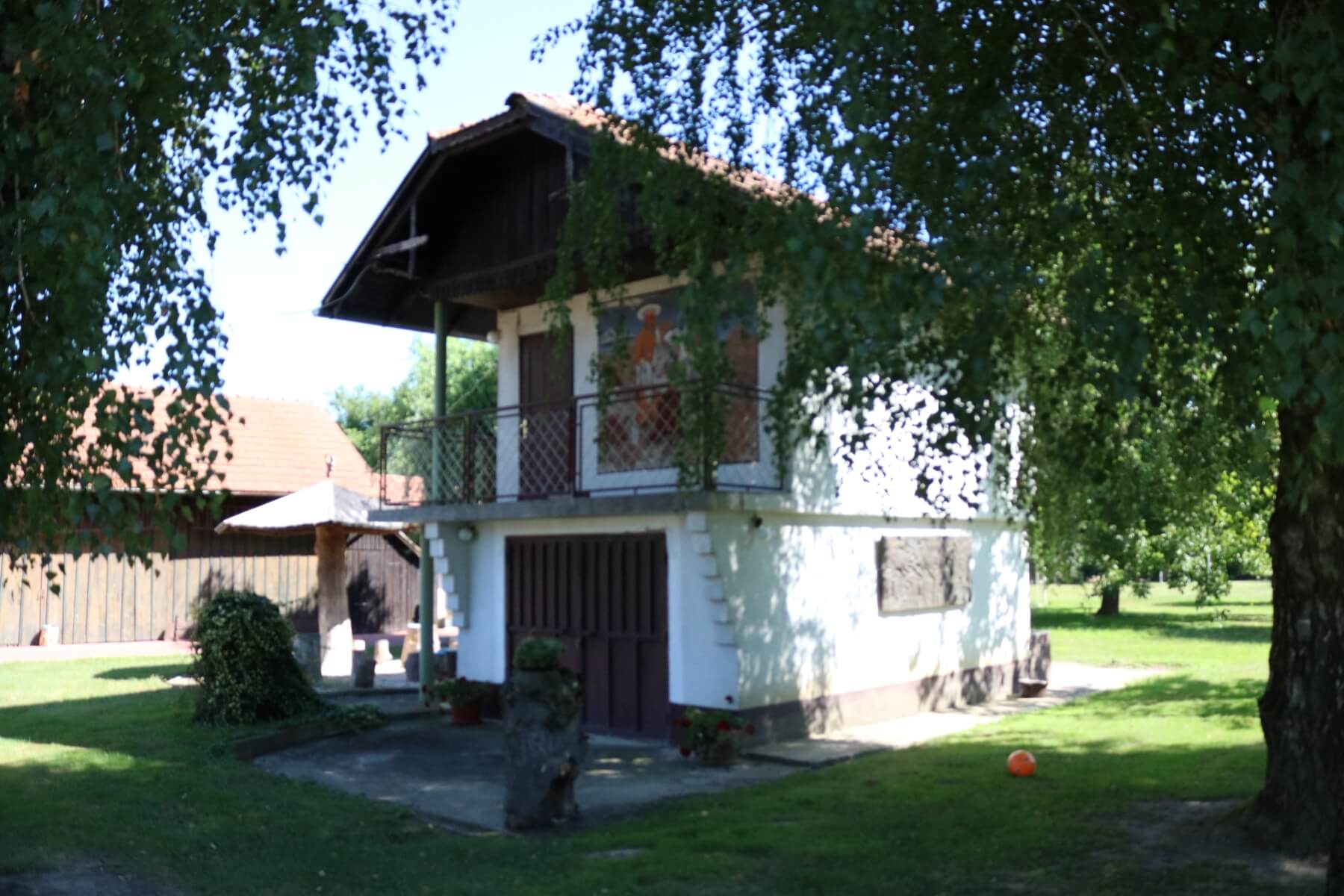
“How long have you got?” asks Ivan Generalić, grandson of Josip Generalić, great-grandson of Ivan Generalić, as he greets you at the Galerija Josip Generalić, Hlebine. He's asking if there's time for the1 hour tour or 6-hour tour. We think he's joking. He's not.
Generalić family have lived here for at least five generations. Having two of the Hlebine School's most famous and most successful painters within their ranks has allowed them to expand their property portfolio. It's just as well, because there's a lot to see here. What was once the simple, semi-agricultural farmstead where Ivan's great grandfather was born is now a sprawling family estate that houses an ethno-museum and considerable gallery spaces filled with incredible exhibits. All of the original furniture from how his great grandfather lived is preserved, displayed as it was, only in an adjoining property the family now own. Alongside the history and many works of Ivan Generalić and Josip Generalić, folk art, sculpture and artisan furniture made by incredible craftsmen from across the Balkans, who the painters once traded with.
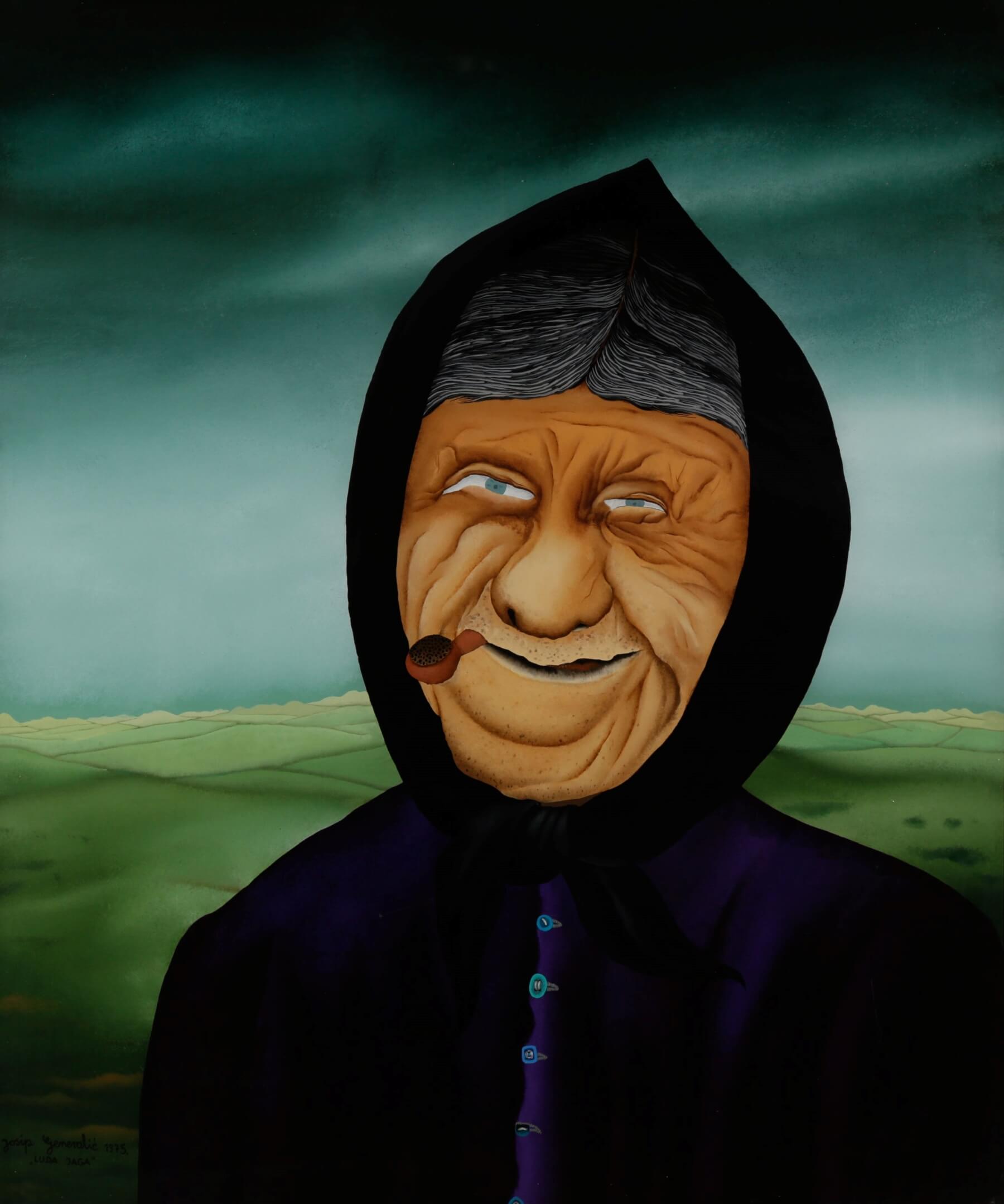 Luda Jaga by Josip Generalić, hanging at the Galerija naivne umjetnosti (Gallery of Naive Art), Hlebine © Koprivnica Town Museum
Luda Jaga by Josip Generalić, hanging at the Galerija naivne umjetnosti (Gallery of Naive Art), Hlebine © Koprivnica Town Museum
If you already like this kind of art, you might have to pinch yourself more than once that you're being shown around by someone called Ivan Generalić. Ivan himself is not only knowledgeable but extremely engaging - there are several big laughs on the tour. Ivan points out one image of an unloved neighbour, who grandfather Josip sent to the moon. He provides him with a Podravina cow so at least he can survive. Perhaps feeling slightly guilty, in the next room, Josip has painted the neighbour's return to earth. Although, he lands nearby in the famously barren Đurđevac desert (sometimes known as the Croatian Sahara). That's quite a lot of time and paint spent on someone you don't like!
Ivan's great grandfather also had a sense of humour. Having grown tired of friends bragging about their holidays in summer houses on the Croatian coast (which he did not like), at the height of his fame he decided to build his own. He invited several friends to accompany him on his holiday. And proceeded to take them to his own back garden, just metres from his main residence, where he had built the summer house. Genuinely, you'll wish you had time for the 6-hour tour. Find out more about the gallery here.
Galerija Ivan Večenaj, Gola
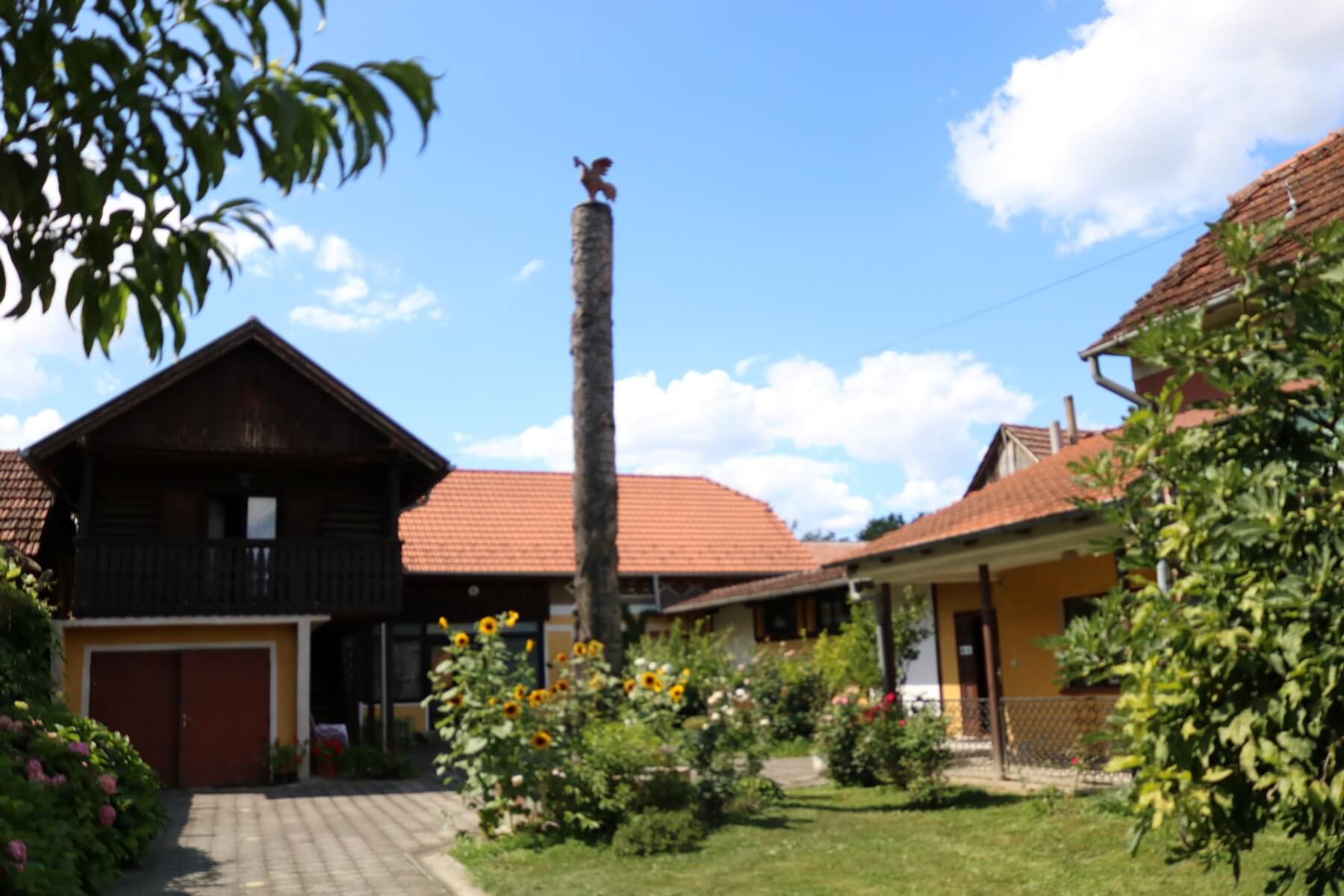
Some of the work by artists from the first and second generation of the Hlebine School are scattered far and wide. But, with the canon of Ivan Večenaj, it's a different story. Truly breathtaking examples of his finest work – definitely among the very best – were reserved by the artist for his family collection. Included in the collection, most of his key sacral works, including Golgotha, a triptych of the life of Jesus, crucifixion and the Four Horsemen of the Apocalypse. Don't worry, it's not all doom and gloom. Beautiful and bright images of Podravina roosters, agriculture and a charming portrait of his wife hang alongside. You can view them all at Večenaj's former home, now Galerija Ivan Večenaj in Gola. Across the road, an ethnic museum preserves life how it once was here. A truly unmissable highlight on the trail of Croatian Naive Art. Find out more about the gallery here.
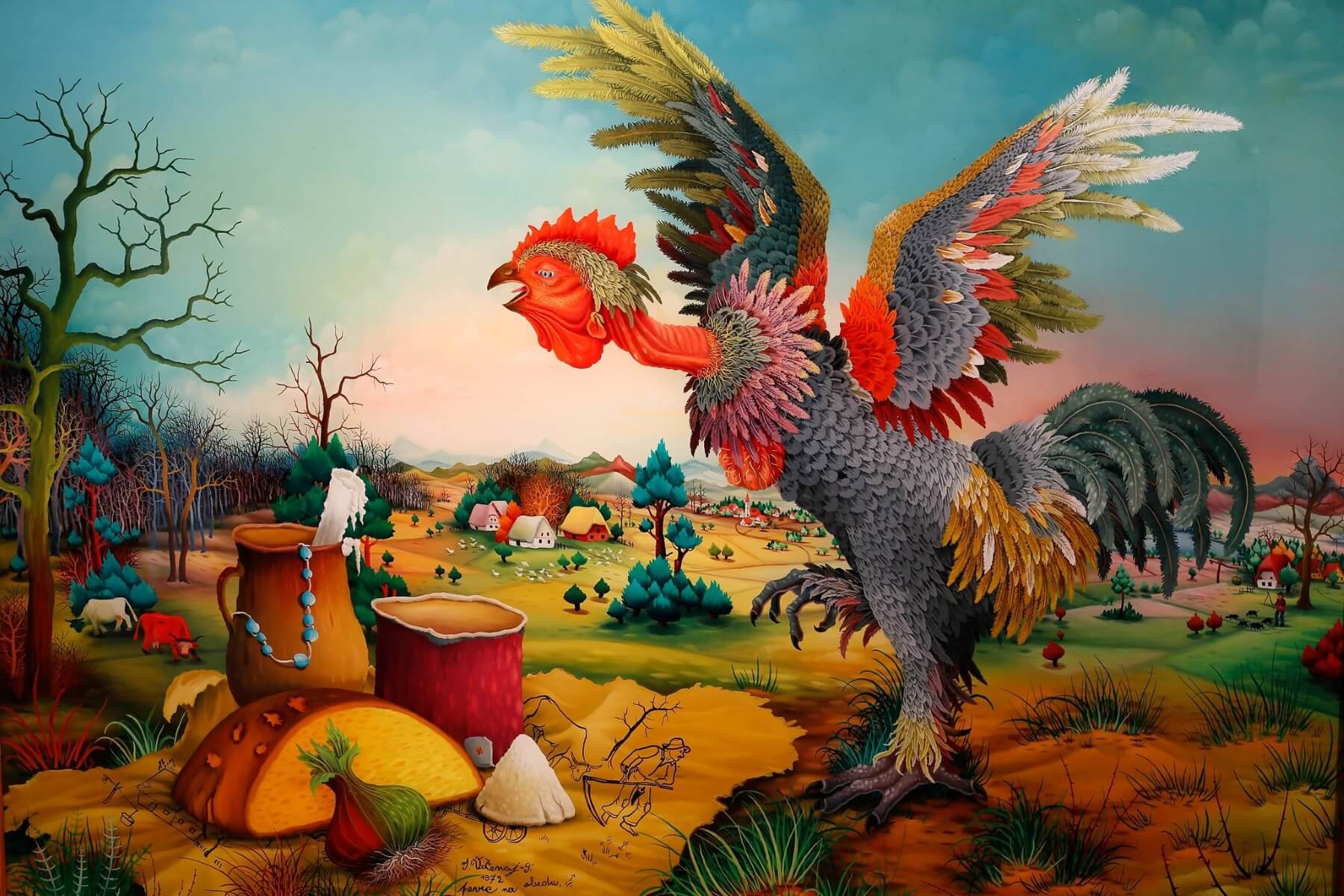 'Pevec na obedu' © Galerija Ivan Večenaj
'Pevec na obedu' © Galerija Ivan Večenaj
Galerija Ivan Lacković, Batinske
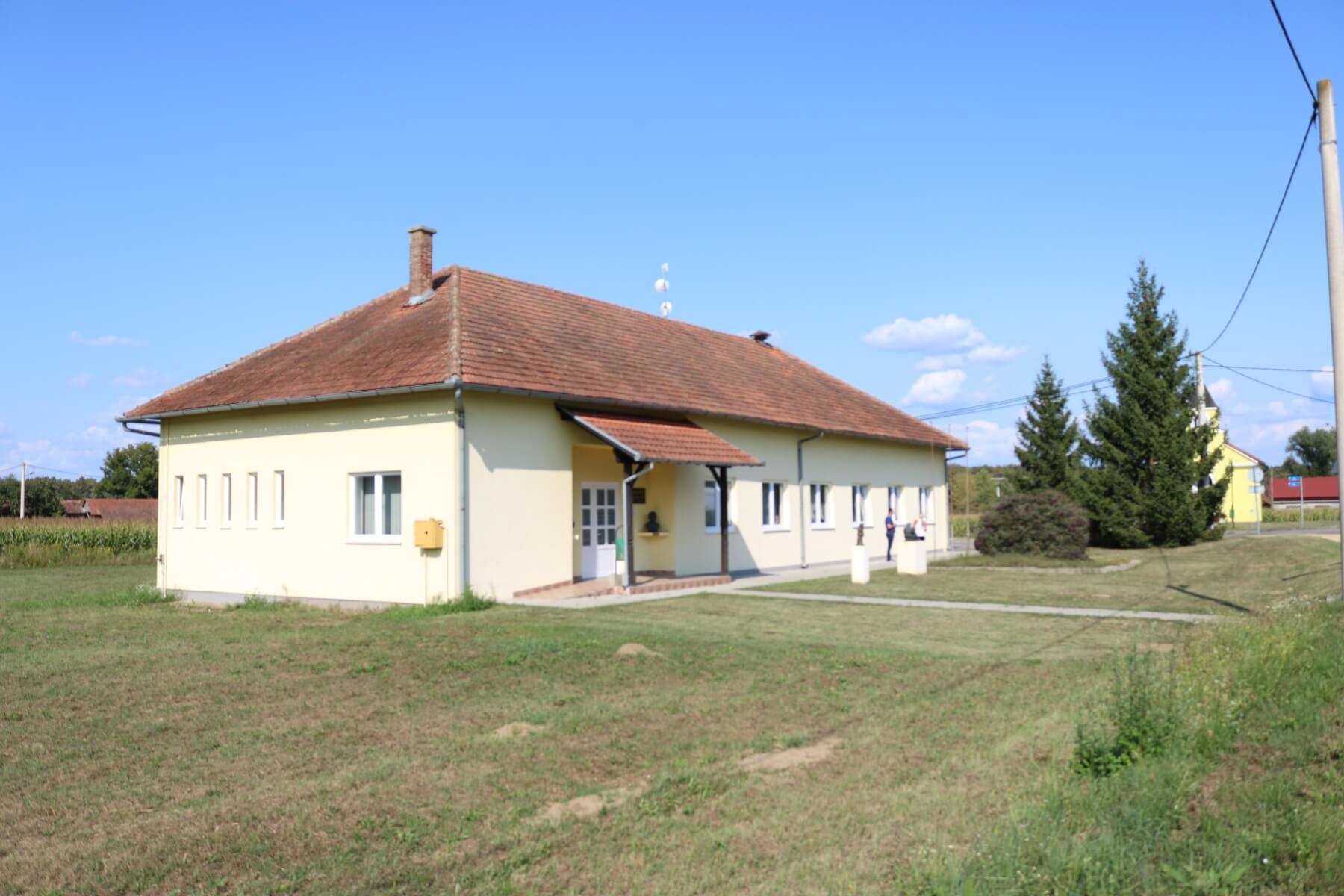
Clearly something of a local patriot, Ivan Lacković donated some 300 works to the village of his birth. Within the collection, you'll find not only works by Lacković himself but also sculptures by Naive Artists Ljubica Marulec and the painter's brother, M. Lacković. Find out more about the gallery here.

Podravina Motifs (Podravski motivi)
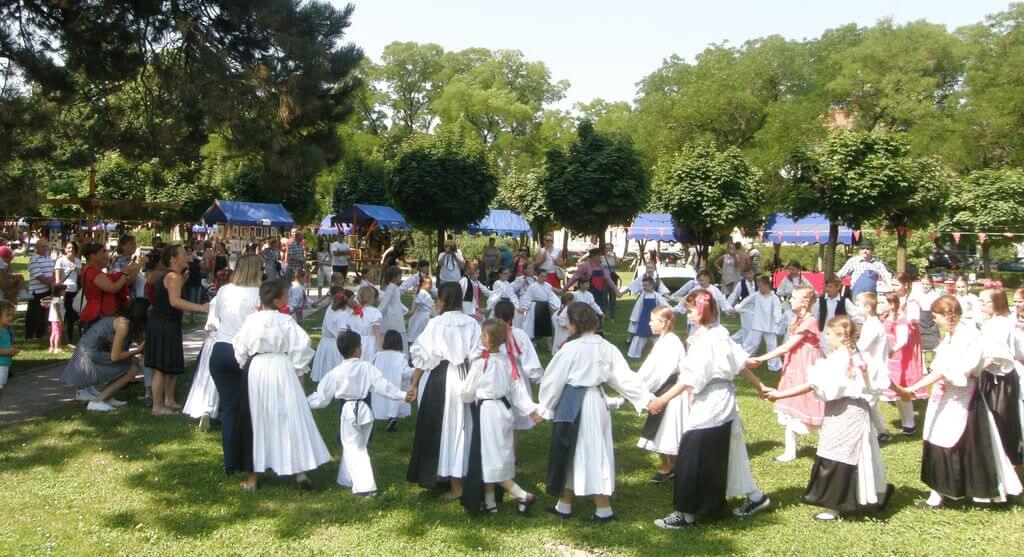 Podravina Motifs (Podravski motivi). Photo © Grad Koprivnica
Podravina Motifs (Podravski motivi). Photo © Grad Koprivnica
A three-decade-old Koprivnica event that showcases all of the cuisine, culture, music, dance, costume and art of Podravina. Naive Art is a key and central theme to the event. Usually, there are over 50 contemporary Naive Artists from the region exhibited, with their work on sale. Taking place each summer, it's a great place to get to know traditional Podravina and to pick up some amazing gifts. Find out more about the event here.
Šetnja kroz naivu u Hlebinama (Walk Through The Naive of Hlebine)
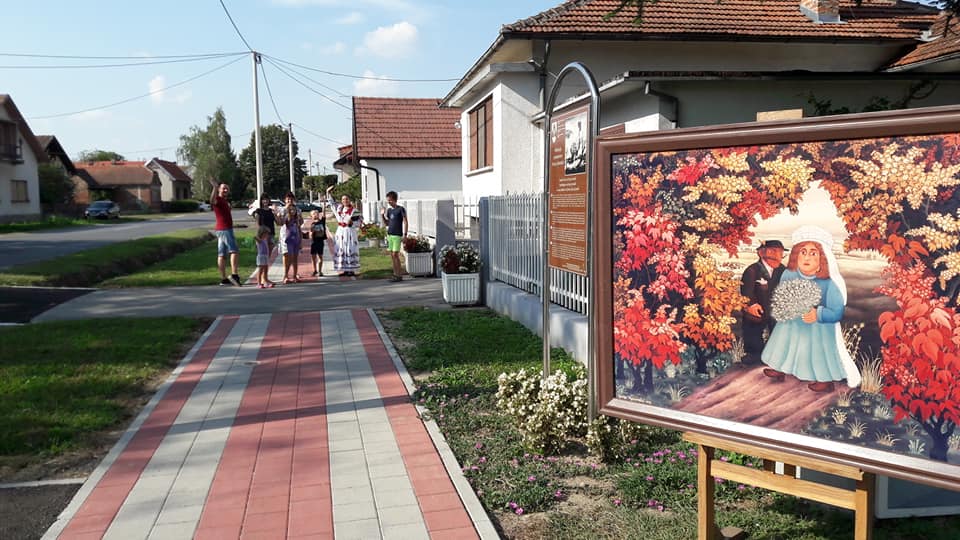 Outside Galerija Josip Generalić during Šetnja kroz naivu u Hlebinama © Tourist Board Central Podravina
Outside Galerija Josip Generalić during Šetnja kroz naivu u Hlebinama © Tourist Board Central Podravina
An annual open-air gallery of Hlebine Naive Art taking place on the streets of the village itself. Organised by Tihomir Želimorski who has the rural accommodation offer Stari zanati in Hlebine, Šetnja kroz naivu u Hlebinama differs from Podravina Motifs because it focusses exclusively on art – painting and sculpture. The houses in Hlebine are treasure troves of Croatian Naive Art. During this summertime event, all village residents bring their paintings and statues out onto the streets, hang them on trees or in gardens. You're invited to walk around the delightful village to look. Find out more about the event here.
This article was produced with the kind help of Koprivnica-Križevci County Tourist Board and checked for accuracy by Koprivnica Town Museum.
If you want to find out the latest from Podravina, be sure to check TCN pages here.
Croatia Basketball 2023 FIBA World Cup Qualifier Group Announced
September 1, 2021 - The Croatia basketball 2023 FIBA World Cup qualifier group has been announced!
In Tuesday's draw for the World Cup qualifiers, Croatia learned its European opponents. Croatia will face Sweden, Slovenia, and Finland in the hope of qualifying for a place in the 2023 FIBA World Cup in Indonesia, Japan, and the Philippines (Jakarta, Okinawa, Manila).
The draw took place at the Patrick Baumann Basketball House in Mies, Switzerland. It was closed due to the epidemiological situation and could only be watched live on the FIBA YouTube channel.
The qualifiers will be played in six cycles over 15 months. Eighty countries acquired the right to qualify, and in a total of 420 matches, 32 national teams will eventually qualify.
32 national teams entered the qualifications at the European level, and we will only see 12 of them at the World Cup. The national teams were divided into eight groups (A-H) of four teams, and in the first phase, each team will have the opportunity to play six games, i.e., home and away games against each opponent in the group.
Group A: Serbia, Slovakia, Belgium, Latvia
Group B: Belarus, Great Britain, Greece, Turkey,
Group C: Croatia, Sweden, Finland, Slovenia
Group D: Israel, Germany, Estonia, Poland
Group E: France, Portugal, Hungary, Montenegro
Group F: Bosnia and Herzegovina, Lithuania, Bulgaria, Czech Republic
Group G: Georgia, Northern Macedonia, Spain, Ukraine
Group H: Russia, the Netherlands, Iceland, Italy
The last-place team in each group is eliminated from the race for the World Cup, and four new groups (I-L) are formed with six participating countries each, which transfer their results to the next phase. Each national team will play six games at home and away against three national teams in their group with which they did not meet in the qualifiers. After all the matches are played, the three first-place teams from each group will win a ticket to the World Cup.
22.11-30.11, 2021
25.11. Croatia - Slovenia
28.11. Finland - Croatia
21.2-1.3, 2022
25.2. Croatia - Sweden
28.2. Sweden - Croatia
27.6-5.7, 2022
30.6. Slovenia - Croatia
3.7. Croatia - Finland
22.8-30.8, 2022
7.11.-15.11.2022.
20.2.-28.2.2023.
Since the European Championship starts on September 1, 2022, the fourth qualifying cycle of the World Cup will also serve as a preparation for the European Championship.
Source: HKS
To follow the latest sports news in Croatia, follow TCN's dedicated page.
To learn more about sport in Croatia, CLICK HERE.
New Šibenik Panorama Oil Painting by Local Artist Welcomes Guests (PHOTO)
September 1, 2021 - A new Šibenik panorama oil painting can be noticed along the D33 road, welcoming tourists to the popular coastal Croatian town.
Welcome boards are often old and worn, which hardly gives an excellent first impression. However, it's important to remember that welcome boards are usually a tourist's first contact with the destination, reports HRTurizam.
Šibenik decided to take the initiative and ensure they gave off a good first impression with a creative project. Namely, earlier this week in Lozovac, along the D33 road, a large double-sided welcome board was set up showing an oil painting panorama of Šibenik, painted by Šibenik graduate painter Lana Martinović Čala of LANAart.
The welcome board was erected on the site of an old welcome board implemented more than twenty years ago, which had been partially devastated and neglected.
The Šibenik Tourist Board financed the construction of the board, and the price of the entire project (technical implementation and preparation) was around 50,000 kuna.
"We intend to replace it next year with similarly cheerful with colorful visuals and replace several other old signs placed at the entrances to Šibenik," said the Šibenik Tourist Board.
"Now everyone who comes to us knows that they come to the city of culture and art, the city of all artists, exhibitions, festivals, and music, the city of fun and good food, the city full of colors and life, the city of happy and good people, the city of friends and positives, the city that grows and becomes better and better, to my city, the city of Šibenik," said Lana Martinović Čala.
Visitors can find the LANAart Gallery located in the heart of Šibenik. In addition to a large selection of art paintings, B.Sc. painter Lana Martinović Čala hosts drawing and painting courses for adults and schoolchildren and creative workshops for children.
For more on lifestyle in Croatia, follow TCN's dedicated page.
Croatian Football League to be Broadcast Internationally to 300 Million New Fans
September 1, 2021 - The Croatian football league matches will be broadcast to more than 300 million people from the 2022/23 season!
After buying TV rights for competitions under the jurisdiction of the Croatian Football Federation for a record amount, Endorphin Magine has signed a multi-year contract with an Indonesian partner that will market Croatian First League matches to more than 300 million people, reports HNS.
Last year, HNS and Endorphin Magine signed a ten-year contract for production and distribution rights for all matches owned by HNS, starting with the 2022/23 competition year.
Endorphin Magine has signed a contract with Indonesian house PT Global Media Visual (Mola TV), which has bought TV rights for the territories of Indonesia, Malaysia, Singapore, and Italy from the 2022/23 season until 2025. As announced by Endorphin, this is the first step in expanding the distribution of the Croatian league worldwide.
"This is an exhilarating time for Croatian football - we are entering new territories and can now broadcast matches internationally to 300 million new fans, which will contribute to the strong growth in popularity of this Top 20 Uefa league. We are delighted to partner with PT Global Media Visual, the market leader. This confirms the recent successes of the national team and clubs and that Croatian football is an exciting value. The Croatian Football Federation is delighted to expand into these new territories and fully supports new stakeholders. In addition, the growing international visibility of Croatian football will further promote clubs and players in these markets," said Endorphin Maginea CEO David Johnson.
"Our company is constantly looking for new and exciting content that allows us to offer our customers the best possible entertainment package. The first Croatian football league has developed into a top football experience. We are thrilled to give our viewers a chance to watch this competition for the first time. Our partnership with Endorphin Magine fits in perfectly with our vision of expanding the sports package offering," said Mirwan Suwarso, PT Global Media Visual’s representative.
"We are happy to hear about this agreement because it confirms the international attractiveness of our First League. We are sure that Mole TV viewers will enjoy Croatian football because the First League has never been more interesting, uncertain, and exciting. This agreement shows that we have chosen Endorphin Magine as an excellent partner who will help us in the development and promotion of Croatian football around the world," said the President of the Croatian Football Federation, Marijan Kustić.
To follow the latest sports news in Croatia, follow TCN's dedicated page.
To learn more about sport in Croatia, CLICK HERE.
Epidemiologist Dijana Mayer: Third Vaccine Possible for Vulnerable Groups
September the 1st, 2021 - Croatian epidemiologist Dijana Mayer has claimed that the situation with the spread of the virus across Croatia currently isn't that great. She also touched on the vaccination of children, anti-epidemic measures and the idea of a third dose of the vaccine this autumn.
As Poslovni Dnevnik writes, epidemiologist Dijana Mayer of the Croatian Institute of Public Health told HRT recently that unfortunately, the situation is not good.
''This week we have an increase in the number of cases from 20 to 25 percent when compared to previous weeks. As the summer draws to a close, as people return to their places of residence and their jobs, the number of tests taken will grow, and we can see that we have an increase in the number of new cases. We have a more significant number of hospitalised people, ie patients with a severe clinical picture who need help in the form of respirators,'' said epidemiologist Dijana Mayer.
"This is one of the important indicators for us because of the hospital system, we need to make sure it isn't burdened abruptly. Hospitals are ready to accept patients, but it would be ideal if there were as few hospitalised coronavirus patients as possible,'' she added.
She noted that more than 80 percent of those hospitalised with coronavirus, as well as patients with a very severe clinical picture and needing the help of a respirator were not vaccinated.
"That is why we're appealing to people to please come and get vaccinated. The vaccine protects against severe forms of the disease developing. It doesn't matter if we get sick and have a mild clinical picture, but it does matter if we develop severe pneumonia where we end up in intensive care, on a respirator,'' she said.
Both doses of the coronavirus vaccine have successfully been given to 51 percent of the Croatian adult population. When asked if we would have to receive a third dose, epidemiologist Dijana Mayer said it was being discussed.
“Vaccination with a third dose is likely to start in early autumn and it will be aimed at older and more vulnerable groups of people, those who are immunocompromised and those with more severe chronic diseases,” she said.
When asked if the remarkably successful tourist season is to blame for the increase in the number of infected people, epidemiologist Dijana Mayer said that we can all be proud and satisfied with the tourist season.
"We're happy that July and August went so well for us in terms of new patients. We're satisfied with the number of tourists who came. Summer is a time to relax and socialise. Of course, any larger gatherings, where people weren't vaccinated, was a potential hotbed of infection and it was a pool for new patients. We believe that the season will be extended for at least another week or two, maybe for even longer,'' said the epidemiologist.
According to the ECDC corona map, Croatia is orange, and Mayer hopes that it will remain so.
"We believe that we'll be able to vaccinate as many people as possible as they return home from being away for summer. People are also being vaccinated wherever they are on the coast. All counties will have vaccination points available from September the 1st, this means that all foreign residents, tourists and locals can come for vaccination. Each county bureau has several appointments and checkpoints. Those interested can easily get information and get their vaccine,'' she said.
The vaccine is registered for children from 12 years of age and older is recommended for those who have severe chronic diseases, who are immunocompromised, and those who have malignant, cardiovascular and lung diseases. Children can be vaccinated by a competent school doctor.
"About 1,200 children up to the age of 14 have been vaccinated, and when looking at those aged 15-19, about 10,000 have had the vaccine. It isn't a large number at the moment, but we're very pleased that the parents are aware and have given their consent for their children to be vaccinated. The covid vaccine isn't mandatory for anyone, not even for children, but it is recommended. Especially because children live in households with their grandparents, parents who have chronic diseases and children can be potentially dangerous for their family members,'' she said.
From September the 1st, currently closed off parts of coffee bars and cafe will finally open, much to the delight of those who have been unable to work for months on end. Epidemiologist Dijana Mayer said that this decision was very much welcomed by all.
"It's the first step in getting back to normal. We hope that people will continue to behave responsibly, that they will wear masks, it's important to ventilate the premises and the owners will surely take care of that. There will be a disinfectant at the entrance to each cafe. It is in everyone's interest that these closed parts of the cafe are able to work normally for as long as possible,'' concluded epidemiologist Dijana Mayer.
For all you need to know about coronavirus specific to Croatia, make sure to bookmark our dedicated COVID-19 section and select your preferred language.
Tourism Pushes Croatian Retail Sector Forward, Analysts Optimistic
September the 1st, 2021 - The excellent tourist season which appears to just keep on going has pushed the Croatian retail sector out of the slump the global coronavirus pandemic had forced it into. Analysts are, unsurprisingly, very optimistic as a result.
As Poslovni Dnevnik/Ana Blaskovic writes, after a record jump in GDP in the second quarter of 2021, the indicators for the beginning of the third quarter, the most generous part of the year for the economy, also look fairly positive. In July, retail spending rose 12.8 percent for the sixth month in a row, reflecting a good tourist season and good economic recovery.
Turnover in the Croatian retail sector (referring to trade, and calendar adjusted) during the month of July increased by 2.2 percent in real terms compared to the previous month. Half a year of consumption growth comes after the previous 11 months of decline, or 5.8 percent of the deficit in 2020.
Retail trade in food, beverages and tobacco products rose 12.8 percent in July, and the non-food segment (excluding fuels and lubricants) 9.1 percent year-on-year, the Central Bureau of Statistics (CBS) calculated.
Raiffeisen Bank analysts point to the fact that last year, with which the trends are being compared and measured, the decline was large.
"Apart from the effect of the base period, the continuation of favourable trends is also the result of the good trends in tourism, moderately positive trends on the labour market, as indicated by data on consumer optimism, which, despite a slight deterioration when compared to June, continued to grow annually," they said.
The passage of time certainly provides for a decent dose of optimism for the performance of the economy in 2021 as Croatian GDP rose 16.1 percent in the second quarter, and perhaps more importantly, it was the first jump after four quarters of worrisome decline.
The Tax Administration's data on fiscalised receipts issued from the Croatian retail sector also show continued double-digit annual growth rates exceeding pre-covid levels, the RBA said, underscoring the good labour market situation and strong spending in tourism.
This continued growth, however, will depend on the development of the ongoing epidemiological situation, which is unfortunately deteriorating with warnings from the profession that we are entering the fourth wave with only 39.4 percent of the Croatian population having been fully vaccinated.
For more, follow our business section.
Zagreb Varionica Brewery Wins Medals at Hong Kong's Asia Beer Challenge
September the 1st, 2021 - The Zagreb Varionica brewery has managed to wow the crowd at Hong Kong's Asia Beer Challenge, highlighting the blossoming world of Croatian craft brewing on a traditionally hard to impress market.
As Poslovni Dnevnik/Sergej Novosel Vuckovic writes, the popular Zagreb Varionica brewery is only continuing its success at global competitions and beer tastings. After winning four beer Oscars at the European Beer Challenge in London, the most important and influential beer competition and evaluation in all of Europe back in May this year, its beers have now conquered the largest continent of all - Asia.
The Zagreb Varionica brewery's medals were awarded in Hong Kong, at the Asia Beer Challenge 2021. It is the largest and most prestigious beer competition in all of Asia, a continent that drinks as much as half of all global hop-based drinks in the modern day. As such, the Asian market is quite difficult to impress.
The gold medal in the American IPA category went to the Hacker black hat edition, a beer recently brewed for and in collaboration with one of Croatia's leading software companies Combis; Varionica's now classic Pale ale also took home gold. The silver medal went to Siesta session IPA, and the bronze to Pop! Lager.
"These aren't the first medals we've received and we're glad that we've managed to maintain a high standard of quality," the co-owner of the Zagreb Varionica brewery, Davor Simicic, said in a recent press release. However, the competition at which they did so well speaks volumes about the sheer value of these awards - samples of their beers were sent to Hong Kong by renowned brands such as Ayinger, Rodenbach, Palm, Hopster, Hofmeister and others. Those samples were then evaluated by very strict criteria, the method of blind tasting, in order to ensure objective and reliable findings.
From now on, therefore, bottles of ''trophy'' beers made by the Zagreb Varionica brewery can be decorated with new medals from the Asian beer challenge, which makes them irresistible to both traders and consumers, they say from the brewery.
"These new medals aren't accidental, but are a reflection of our true love for beer and our commitment to quality, this is a great success of our entire team," said the co-owner and chief brewer of Varionica, Matija Mrazek.
For more, make sure to follow Made in Croatia.


